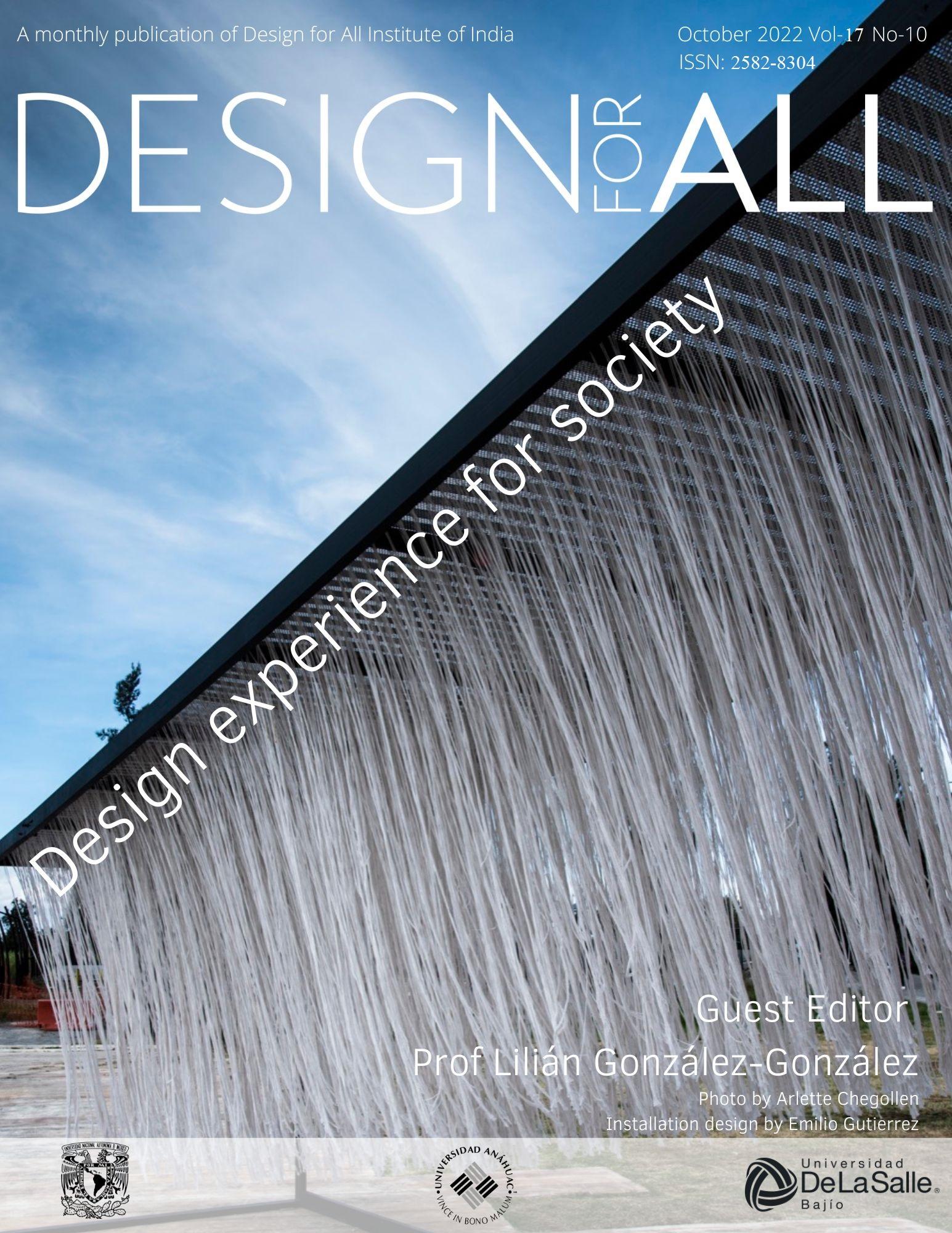

Guest Editor
Prof Lilián González-González www.designforsociety.orgIndustrial Designer, Academic coordinator at Anahuac University of México, Board member in the World design organization and an Owner associate at NUB / furniture factory where she is a strategy consultant.

Is a PHD candidate in Critical Theory about "Social design experience", currently is studying a certificate in Disability Critical Theory. She has a Master degree in Contemporary art and a Speciality certificate in sculpture, drawing and art in Florence, Italy where she won different prizes as an artist and made individual and group exhibitions.
She had the opportunity to work as a designer in the industry and as a professor in several Universities and cities around Mexico. With experience in the Mexican design industry, government and manufacturing. She also worked in General Electric Energy for 5 years, obtaining different certifications in the meantime about quality and design.
October 2022 Vol-17
for All Institute of India
2582-8304
Also, was a Co-founder and organizer for various international conferences, talks and symposiums about art & design. Also was invited as a speaker in several Universities and congresses nationally and internationally.
Her Design research and development expertise is in esthetics, symbolic meanings, manufacturing process, healthcare, disability, inclusion and sustainability.
Until today she is a writer about philosophy, art and design since 2008 at www.designforsociety.org
October 2022 Vol-17 No-10 Design for All Institute of India
Guest Editorial:
Prof Lilián González-GonzálezObjects have been evolving naturally, as has art, society, and not only from an aesthetic and functional point of view; the idea of the object has exploded and has become more complex, because the emotions and experience must also be contemplated and designed. We are in trans-aesthetic moment in which the majority wishes to have an aesthetic experience through the way we dress, the places we frequent, and even how we decorate our homes regardless of economic status and this can transform reality and everyday life. Society is no longer satisfied only with objects beauty and function; the discipline of design has overcome any social and economic barrier to be able to contemplate and prioritize emotions and experience.
Aesthetics conceived as beauty in the traditional sense of the term can already be found in other places contaminated by the desire to create their environments and aesthetic experiences, and it is not that this desire is new, but the mass products, the large production, and distribution of these products make them available to anyone, whether high or low quality but they have to be under the regime of a fashion trend and generate an experience, and if not, the user will not consume it.
It is here where trans-aesthetic experiences are found, places that generate experiences, restaurants that not only offer food but also experiences of encounter, objects that awaken the user’s interest
2582-8304
and that talk to him, that respond beyond their function to his emotions. Clothes that not only position you in a status but also arouse interest, curiosity, help, like brands that tell you stories in which they show you the process or the people who help with your purchase, to give an example. We see how the individual that has generated this consumer society, now seeks new products, new emotions and experiences. There are too many products that are generated every day, so now we are looking for those that are unique, those that seem that only I have them but at the same time are fashionable and make me belong to a group.
The postmodern user is not only looking to satisfy his aesthetic desire, which is what has been fought against throughout history (beautification of objects) but a movement in which the object has to give something more than its mere function and beauty. Now it must also give an experience.
October 2022 Vol-17 No-10 Design for All Institute of India
Carolina Magaña Fajardo

PH.D., M.A. and B.A. in Architecture from the Universidad Nacional Autónoma de México. She has completed two postdoctoral stays, one at the Instituto de Investigaciones Estéticas de la UNAM and another at the UAM, campus Xochimilco. She is a specialist in the history of 20th century architecture, with a diploma in Interior Design from the Universidad Iberoamericana, a diploma in University Teaching Training from UNAM, a diploma in research from Anáhuac México, a course in Historical Avant-Garde at Casa Lamm and more than twenty courses. She is a member of the Academic Committee of CENEVAL. She is currently coordinator of the area of Research, Communication and Culture of the Faculty of Design of the Universidad Anahuac Mexico in the south campus and professor of subject "A" definitive in the Faculty of Architecture, UNAM. She has more than 15 years of teaching experience; he has collaborated in several research projects, papers, and published more than 15 articles in various national and international journals on topics of the History of Architecture and Design of the twentieth century, housing and border issues. And published the book "Art Deco in Mexico City. Retrospective of an architectural movement" in 2019.
2022 Vol-17
Design for All Institute of India
Liliana Ceja Bravo
PhD in Sciences and Arts for Design in the area of Critical Theory and History from the Universidad Autónoma Metropolitana, a Master's Degree in Visual Arts with orientation in Design and Visual Communication from the Universidad Nacional Autónoma de México.
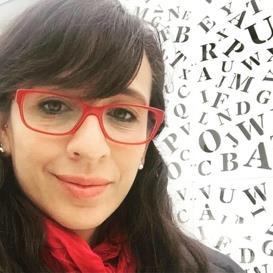
Degree in Graphic Design from the Universidad Vasco de Quiroga. She has given lectures at various national and international events and universities. She has published in national magazines, as well as in anthologies of academic colloquiums. He coordinated the publication of the book "Coordenadas gráficas. Experiences, pedagogies and practices of Design" by FAMADyC. Published by De la Salle Ediciones. She was a member of the Quality Committee of the Coordination of Research and Experimentation Networks for Design and the Arts (CORIEDA) of the Faculty of Arts and Design, UNAM. From 2019 to 2021. She is currently Coordinator of the Center for Research in Design at the Faculty of Design at the Universidad Anahuac Mexico, North Campus. She has participated in work teams for the curricular design of the degree in Design for Communication in Digital Media for the Universidad Latinoamericana campus Florida and the degree in Product Design for the Universidad La Salle, Mexico City.
8 October 2022 Vol-17 No-10 Design for All Institute of India
2582-8304
He has 14 years of teaching experience in various universities in Mexico City teaching undergraduate, masters and doctoral classes. His lines of research are oriented to creative processes for design. Complex and systemic thinking for design. Interdisciplinary and transdisciplinary.
October 2022 Vol-17 No-10 Design for All Institute of India
Advertising and emotional design in the construction of the image of Mexican women in the first half of the 20th century
Abstract
The article links the advertising strategy, what we know today as emotional design, which led Mexican women at the beginning of the 20th century to acquire appearance and hygiene products to identify themselves as modern women. This is a descriptive and analytical qualitative research based on newspaper and documentary elements from the newspaper “El Universal” in 1935. It aims to expose the way in which the success of a product does not depend solely on the functional objectives from which it was originally designed, but on the meaningful relationship it establishes with the user.
Keywords
Emotional experience, advertising strategy, image of modernity, personal care and hygiene products
Introduction
When reviewing early 20th century magazines, we are usually struck by the number of advertisements aimed at women promoting personal hygiene and household cleaning products. What facilitates
Dr. Liliana Ceja Bravo and Dr. Carolina Magaña Fajardo
1
the proliferation of this type of advertising? Why was advertising design aimed at the female public? What characteristics did advertising design have to influence the image and way of life of the modern woman?
The text aims to show how advertising and product designs focused on the appearance of Mexican women contributed to the creation and consolidation of their image from the perspective of female subjectivity. This was possible thanks to advertising strategies 2 based on the principles of what we know today as emotional design, which led consumers to purchase products to identify with the woman who entered modernity.
Body of the article
To develop this, we must connect three events that happened in unison: the ideas of progress imported from abroad; the public policies that largely adopted these ideas (sports, hygiene and technology) (Magaña, 2021); and how this conjunction spilled over into advertising, opening up a consumer market for a large number of products focused on women's appearance.
First and foremost, the legal actions taken with regard to public health and education after the Mexican Revolution (1910-1921) were fundamental, because since the government of General Porfirio Díaz (1876-1911), both the economic stability of the country and the living conditions of the population had been neglected. Therefore, when José Vasconcelos coordinated the two major campaigns -
1 We refer to the modern woman as the one belonging to the interwar and postwar era who sought to radically break with the image of the submissive person, the self sacrificing mother and in general with the dominant gender discourse of the time.
2 It is an action plan that aims to persuade people to buy a product or service by communicating brand values and product information through messages using various media.
11 October 2022 Vol-17 No-10 Design for All Institute of India
2582-8304
hygiene and literacy in 1920 - he facilitated the teaching of hygienic habits, personal cleanliness, bathing, healthy eating and, through sport, a beautiful and healthy body according to the standards established at that time in Europe. As scientific and technological advances were developed, sanitation was integrated into the daily practices of Mexican families in all social classes with the so-called "hygiene with appearance".
To achieve this, the health authorities relied on the publication of pamphlets, magazines, lectures, cinema exhibitions and broadcast. In this way, various ways of preventing, and even eradicating, diseases were proposed through home remedies or medical information provided by hygienists. Edith Molina comments that the government's motto from the six-year terms of Pascual Ortiz Rubio (1930-1932) and Abelardo Rodríguez (1932-1934) was "hygiene, the basis of the national economy"; Arechiga refers to this as the period of "hygiene education and propaganda". Hygiene is recognized as a branch of scientific medicine which, if used well, would lead to "perfect health and happiness" (Molina, 2009). It was thanks to this impulse that advertising campaigns advertising medicines and objects for hygiene (cosmetics, perfumes, creams, personal hygiene and detergents) started to become socio-cultural and commercial objects that offered the possibility of a cure and health (Magaña, 2021, p. 11).
The ideas of progress that were emerging at that historical moment were aligned with those of modernity, which had to do mainly with technological and educational development. It is worth remembering that several of these ideas - of hygiene and personal appearance - were adopted from foreign ideals, mainly American and European, which began in manuals of civility and good manners
October 2022 Vol-17 No-10 Design for All Institute of India
3
2582-8304
published from the mid-19th century; for example, Carreño's Manual (1853), which contains lessons and advice on how people should behave in public and private places in order to appear elegant.3
The last link is found in the role that advertising played in the dissemination and consolidation of these ideals. For example, the first advertising agency in Mexico was Maxim's (1911-1927), which was the pioneer in having an area of planning, development and creation of advertisements and having accounts of important companies such as the American branch of Palmolive, leader in the beauty and personal care products market. In its early years, the advertising that was carried out was an import of foreign advertisements that were translated, reinterpreted and adapted to the Mexican reality. Similarly, given this gender revolution that had an impact on the social and cultural spheres, women were considered a very important consumer niche in the economic sphere, which is why advertisers sought to develop new strategies for the promotion and sale of various design objects aimed at this new market. Such was the case of the American agency J. Walter Thompson (1889 to date) who, at their headquarters in New York, implemented a creative department focused on the female gender, whose main objective was to understand the needs and desires of women in order to persuade them to purchase new products and services differentiated by gender.
In this way, advertising advertised three major items: new technological and scientific advances applied to different utilities of
It should be noted that the concept of cleanliness that was generally referred to revolved around appearance, as the important thing was to hide dirt and stench, which is why various cultural and scientific publications insisted on aromatizing and disinfect bodies and spaces.
13 October 2022 Vol-17 No-10 Design for All Institute of India
2582-8304
everyday life (such as lamps, steam irons, hoovers, blenders, refrigerators, phonographs, cameras, automobile), as well as minor and decorative appliances. The second was the new pharmaceutical industry with cosmetics and health care products. And finally, the promotion of new residential subdivisions and single-family housing. This triad meant that the new aesthetic canons were applied and directly represented the fashion of the moment, the contemporary and the good life (Ortíz Gaitán, p.67).
By 1922, the importance and relevance that advertising was acquiring for companies the development of advertising strategies to materialize in their own style and design, including packaging and brand design, becoming fundamental and differentiating elements that allowed consumers to identify with the products, and in turn, that the products competed for the attention of consumers. This contributed to the consolidation of many national and transnational companies that settled in Mexico, as mentioned by Luz del Carmen Vilchis (2010) .
"(...) this allowed these companies to reaffirm their image and identity in the eyes of consumers thanks to the use of various advertising strategies in which they sought to unify the elements that would capture the consumer's attention, retain their acceptance and gradually turn them into regular customers" (p. 187).
At the same time, health became something aspirational and refined, even a bargaining chip for going to public and private spaces such as squares, sports centers, and churches, to name a few. It was a value instilled in households, which also encouraged the opening of a market for cleaning and personal hygiene products aimed
October 2022 Vol-17 No-10 Design for All Institute of India
2582-8304
primarily at women who had the purchasing power to buy the products, as well as household service staff to use them. In this way, advertisements for these products became popular in the press. The female image associated with these products was that of a modern, cosmopolitan and sophisticated woman known as a "flapper", who had an identifiable physical appearance and who undoubtedly followed the canons of how to behave and care for her family when using the products.
"(...)she was a beautiful woman, exaggeratedly produced, very pale, with very red lips and profusely painted eyes. Her dress was short, her skirt only an inch below the knee and she wore black stockings and her main feature was short hair" (Hershfield, in Sánchez, 2018, p. 62).
Image 1. Propaganda for "El jabón Rosa de Guadalupe” (Rosa de Guadalupe soap). Source: Revista de Revistas January 16, 1927. Hemeroteca Nacional de México (HNM)
October 2022 Vol-17 No-10 Design for All Institute of India

women to seek to look like "the woman in the magazine". Images that constituted a visual language that apart from communicating and teaching, in some way proposed aesthetic canons of how a family should design their home according to the social status to which they belonged or wanted to belong (image 1). They were represented as tall, well-dressed, slim women, with complexions free of any imperfections and loved by their husbands and families for the way they conducted themselves in social circles and managed the household. It also implied a rethinking of their role in women's social life. She was now no longer confined to the domestic environment, but participated in the economic, political and cultural spheres. This image of the "flapper" arrived in Mexico through the influence of cinema, foreign fashion magazines and the radio, which spoke of a modern woman who showed her beauty and sought her own expression of freedom through a new relationship with her body and its care. In short, how a woman should smell, dress and be a woman who should show herself to society.
October 2022 Vol-17 No-10 Design for All Institute of India

Between 1920 and 1950, advertisers encouraged the creation of habits, promoting the use of perfumes, creams, mouthwashes and hair tonics, thus evidencing the new conception of beauty and personal care 4 . This image caused a great upheaval in Mexican society, questioning its indigenous and cultural traditions, completely modifying the traditional image of Mexican women with their long braids falling over their shoulders. They were even called, pejoratively, "las pelonas" ( hairless) (image 2). However, it influenced the construction of a new woman who was no longer just a wife or mother, but was now an active, healthy woman who sought to construct her own identity through her appearance.
This supports Sosenski's theory that "it was in this century that advertising was a powerful means of disseminating discourses about smell, as well as an educational agency that promoted everyday practices, taught the conception of hygienic and unhygienic and disseminated moral ideas" (Sosenski,2020, p. 259), i.e. a market of images was produced to construct appearance in the likeness of what was published.
Emotional design and design
Faced with the growing market for products, advertising began to look for other ways of communicating with consumers, thus
4 During this period, Frohan's branded gum care, Listerine toothpaste, Kolynos toothpaste, Pebeco and Colgate toothpaste proliferated. Soaps Palmolive, Rose of Guadalupe, Mennen, Pompeia, Hinds, Nivea and Gillete shaving cream.Beauty powders to lighten brown skin Flo, Estrellita, Conejos, Orkilia as a symbol of a better status and of freshness and well-being o This era also saw the introduction of the feminine sanitary towel Kotex, or Kleenex tissues, as well as various brands of perfumes such as Chanel No 5, among others (Maga a, 2021, p. 18 and 19).
17 October 2022 Vol-17 No-10 Design for All Institute of India
resorting to a new graphic style. There was a radical change in the use of the image - which was generally a drawing - since previously, what predominated was text, referring much more to the description and explanation of the functioning or tangible qualities of the product. This changed over time and the image began to play a determining factor in the composition of advertisements, being in charge of communicating the main idea. The aim was to make women see themselves reflected in the advertisement and want to buy the product.
These advertising strategies were the first precursor of what we know today as emotional design. We define it as a way of connecting the public with the product, as Caldas says below.
Image 3. Advertisement for "Estuche de polvo compacto con su retrato retocado en colores a mano” (Compact powder case with her portrait retouched in handcolored colors). Source: Journal “Revista de Revistas” Febrary 20, 1927. Hemeroteca Nacional de México (HNM)
October 2022 Vol-17 No-10 Design for All Institute of India

"a way of designing that reflects the crucial role that emotions play in the human capacity to understand the world and, moreover, promises to improve the quality of life of its audience. An emotiondriven design that enhances the relationship between the audience and the product and creates deep emotional bonds between the former and the latter" (Caldas Sara, 2021, p. 38).
When we refer to emotional links, we start from the assumption that emotions are "the intense and temporary alteration of the mood, pleasant or painful, which is accompanied by a certain somatic commotion (RAE, 2022)". In other words, emotions are responses to stimuli that are connected to bodily reactions (image 3). For its part, emotional design tells us how emotions play a fundamental role and that they are the way to know, understand and connect with the world. For Antonio Damasio (1995), emotions and feelings work alongside reason, as he mentions:
"Emotions and feelings are responsible for our actions, at least partially, in conjunction with other mechanisms linked to reasoning. They help us to make predictions, to plan future actions according to these predictions and to participate in cognitive and communicative functions (Caldas Sara, 2021, p. 39)".
Therefore, emotions are important when making decisions. Damasio determines that emotion and reason are connected, i.e., that "pure reason does not exist: we think simultaneously with our brain and with our emotions" (Caldas Sara, 2021, p. 39). Although this knowledge was not available from the 1920s to the 1940s, it is true that advertisers and advertising designers (today called graphic designers) understood perfectly well that communication, packaging
October 2022 Vol-17 No-10 Design for All Institute of India
2582-8304
design and branding were crucial aspects for consumers to identify with, desire and consume the product. Also, in the face of the rise of beauty and personal care products, it allowed them to differentiate themselves from their competitors. This made consumers 'connect' emotionally with the products.
In relation to this, products unleash cognitive activities in the consumer such as interpretation, thought, and memory, generating experiences that are connected to sensations and emotions, which are called emotional experiences. In this regard, Csikszentmihalyi (1981), identifies that there are emotional powers that products emit and categorizes them into three temporal phases: The first refers to products that function as stimuli to generate new emotional experiences; the second as products that function to extend a current emotional experience; and the third, as products that function to remember an emotional experience already lived.
Today, we know that "the designer has to find a way to empathize with the user's values, aspirations and culture" (Lupton, 2018. p. 60) and that he or she is the facilitator of such experiences. In this sense, the main function of advertising during this period was to generate sensations in the consumer, whether out of fear of socially embarrassing situations - such as bad breath or not dressing appropriately - or because of the need for acceptance by a social group or for personal wellbeing. It is therefore not surprising that the most popular products were breath fresheners, skin care products and beauty powders to lighten skin tone, as mentioned.
"(...) so that by 1950 there were already 30 brands of toothpaste, mouthwash and toothbrush on the market. Kolynos
October 2022 Vol-17 No-10 Design for All Institute of India
2582-8304
Cream with the advertisement: "Girls, if you want to have white and attractive teeth instantly use Kolynos cream", or "I love your teeth so nice and so white" (Maga–a, 2021, p. 17).
The advertising of women's personal care products sought to stimulate the desire to beautify the appearance of women of the time, either in an aspirational or transactional way, i.e. that a woman who was "well-groomed, pretty, slim" would encourage women to seek a relationship and get married.
All of this contributed to the fact that advertisements no longer focused only on extolling the goodness of the product but on how the product could help them to have meaningful social relationships, so that advertising could include tips on fashion, good dressing or how to have a healthy, sporty and attractive body.
Therefore, the products of the time and the way they were advertised promoted an emotional connection directly to the prevailing ideals of the modern woman and used the image of the ideal, sensual, independent woman.
Taking up what Csikszentmihalyi mentions about the stage at which products that work to extend an actual emotional experience, it can be alluded that, in for the marketing of beauty and personal care products, five types of advertising strategies were mainly used to connect with women consumers: "Modern testimonial, advertorial, 'friend' advice, 'celebrity' endorsement and the photonovel (Sivulka in Sanchez, 2018. p. 47)". All these strategies aimed to arouse emotional responses in the consumer; to identify
October 2022 Vol-17 No-10 Design for All Institute of India
with the experiences of others; to connect "amicably" with another consumer; to receive expert advice, always using empathy and the aspiration to look like the one advertising a product to you. Advertising was based on the principle of "honesty" where what we know today as storytelling served as an emotional anchor to connect with consumers. One of the most widely used strategies in advertising in the 1920s and later in Mexico was the photonovel "a story was told through three vignettes; the first indicated the problem, the second revealed the promoted product and, finally, it solves the problem in the last vignette (Sivulka in Sánchez, 2018. p. 57)".
All these strategies helped to construct the narrative of what a modern woman had to be like, how she should dress, behave and what products she should consume; they helped to generate sensations such as social belonging, aspiration to have a love relationship or to look like the star of the moment. For its part, the design object - be it toothpaste, perfume, beautifying powder - had to be looked at, touched and used, as a degree of trust is placed in it through an emotion. Santoyo comments that "a well-designed object will be one that is so firmly established in our lives that we cannot imagine the hard everyday life without it" (Santoyo Bahamon, 2015, p. 33). In this way, a bond of need and desire is created to satisfy hygienic demands, but also social and belonging demands. In other words, the object is a bridge between the person and the function, but in the end, it feeds the desire to resemble another through the consumption of the object.
October 2022 Vol-17 No-10 Design for All Institute of India
Conclusions
We can conclude that the construction of the idea of the "modern" woman, generated during the first half of the 20th century, was the detonator of an opportunity for the commercialization of hygiene products focused on women, in such a way that advertising had a prolific field of action in the commercialization of these products. Advertising design realized that the success of a product did not depend solely on the utility for which it was originally designed, but on the meaningful relationship it established with the user. This was reflected in the way it was sympathetic to the aspirational and cultural values of the women of the time. And finally, advertising was the catalyst for the culture of the period, it was a testament to the way of life and constructed the ideal of what a modern woman's hygiene and appearance should look like.
2022
Design for All Institute of India
2582-8304
References
Caldas, S. El poder del Diseño gráfico para generar emociones en Grafica, vol 9 num 17 (2021) Universidad Autónoma de Barcelona
López de Léon, R. (2011). Tópicas en la publicidad gráfica en la prensa mexicana de 1920 a 1968: la sociosemiótica como herramienta de análisis visual. Tesis Doctoral. Ciudad de México: UAM
Lupton, E. (2019). El diseño como storytelling. Barcelona: Gustavo Gilli
Magaña Fajardo, C. (2021). Diseño art déco en productos de higiene personal y domésticos en la etapa posrevolucionaria para la clase media en la Ciudad de México, 1925-1945. Academia XXII, 12(24), 5-28.
Molina Carmona Edith , “El discurso publicitario sobre salud: configuración de un corpus”, en: Veredas. Revista del pensamiento sociológico (México: uam- Xochimilco, 2009), 23-36.
Norman, D. (2012). Por qué nos gustan (o no) los objetos cotidianos. España: Paidós
Rubestein, A. La guerra con “Las Pelonas”, mujeres modernas y sus enemigos, Ciudad de México 1924. En Cano, G. (2009). Género, poder y política en el México Moderno posrevolucionario. México: CFE-UAM Iztapalapa
24 October 2022 Vol-17 No-10 Design for All Institute of India
2582-8304
Santoyo Bahamon, M. (2015). Manifiesto hacia un diseño emocional. Barcelona: EINA Centre Univeersitari de Disseny i Art de Barcelona. Sanchéz, Bracamonte, J.J (2018). Publicidad y deporte en el México posrevolucionario. Tesis maestria. Ciudad de México: UNAM.
Sosenski, Susana “El olor del aliento en la publicidad de la prensa mexicana (1920-1950)”, en: Elodie Dupey García y Guadalupe Pinzón Ríos, De olfato. Aproximaciones a los olores en la historia de México (México: Fondo de Cultura Económica, 2020), 259.
Vilchis, L. (2010). Historia del diseño gráfico en México 1910-2010. México: INBA-Conaculta
October 2022 Vol-17 No-10 Design for All Institute of India
Full-time Research Professor at the Faculty of Design of the De La Salle Bajío University (León, Guanajuato, Mexico). Doctor in Design Development and Teaching from the Madero University in Puebla, Mexico. Member of the National System of Researchers (SIN) Level

I. He is the author of 4 books and various articles. Some of his areas of interest are: the Complexity Paradigm, Design Research, Social interactions, and Cultural and Artistic Research. It’s Research Line is Entitles: Facilitating Spaces and Experiences in human contexts, whose objective is to investigate the different forms of human interaction, given in different configured spaces, and how these influence to a greater or lesser extent to maximize the experience, that is, think of them in terms of interactions, emotions and experiences, recovering the intention, value, contribution and voice that the persons has, through the contribution of design and thereby supporting good living.
2022
Abstract
A recurring theme in our days is oriented to experiences, but when these are linked to the field of design, review an ever greater importance, the reason for this has to do with the very configuration than the design of an experience implies and this fact summons the integration of various areas of knowledge, both of a disciplinary nature and from others, such as psychology, sociology ore anthropology.
Under this context, the present work seeks to reflect on the importance than the design of experiences has from the point of view of environmental design and spaces and how this configuration can have repercussions in the social sphere. For this purpose, work experiences have been considered based on the work of 18 students who are currently integrating the Specialty in Consumer Experiences, a course that is taught within the Faculty of Design of the De La Salle Bajío University, in the city of Leon, Guanajuato, Mexico.
Bries reflection on the effect of experience design and its social implication in the context of the Consumer Experiences Specialty
Leobardo Armando Ceja Bravo (Morelia, Michoacán, México 1975)
The research projects of the students constitute the raw material for the reflection and analysis of the importance that the design of experiences has in the social environment, at the same time, they are the background of the present work, so they will only be referring to specific or punctual aspects of what has been identified in the research process that each student has been carrying out in a particular way, but that in all cases link the design of experiences and their social implication.
Keyword: Design of experiences, Context, Consumption, Digital Space, User.
Introduction
The present work is the product of the reflection on the importance of understanding the discipline of design as a project activity oriented to the resolution of problems and how it’s that said object of design can contribute to the development of experiences, which must be understood from the context in which they are generated, since they are oriented to a specific group of people. In this sense, thinking about the needs or requirements of people will be essential. In the same way, it will be necessary to understand the object designed though the social impact that it generates. Another equally important aspect is the emphasis placed in this text to reflect on the training experience that can be evidenced through the review of the various case studies presented by students of the Specialty in Design of Consumer Experiences, a program taught within from the Faculty of Design of De La Salle University, Bajío, in the city of León, Guanajuato, Mexico.
October 2022 Vol-17 No-10 Design for All Institute of India
Body of the article
The degree of complexity involved in the identification, analysis and determination of both tangible and intangible aspects that people perceive, shows the breadth of knowledge and the prevailing relationships when analyzing a space and the people who come to them. In this particular case, as we are referring to commercial spaces, the need to have visual merchandising, lighting, colorimetric, brand identity and products must have a visual integration that, together, seeks to communicate and link to their brands and products with its users. In addition to this, the digital environment takes on a special importance, since in the case in which we are responsible for identifying the experience given between people, brands and products, it has been possible to analyze from these two dimensions, namely, the space physical and digital space.
The research process developed by the students constitutes an important source of record and documentation of experiences, all of them oriented to various local brands whose scope and projection may be varying depending on the positioning and trajectory of the brand itself.
In this sense, brands of young local entrepreneurs can be identified, as well as brands with a long history and, therefore, better positioned.
All the information obtained constitutes in itself a significant sample of the context in which the present work is developed, likewise, it’s possible to reflect on the importance of research oriented to the design of experiences and the social impact that they have, finally, they can identify some of the resources, strategies and actions that
Design for All Institute of India
2582-8304
brands use to engage with consumers and how and how consumers respond.

Nathan Shedroff 5 has been in charge of identifying the six dimensions that make up the experience and under this approach, a follow-up route, investigative systematization and visibility of investigative processes aimed at understanding the resulting experience can be established.
For this purpose, it’s essential to understand each of the six dimensions that make up the experiences according to this author.
Image 1. Example of general application of the proposed model, based on the interpretation applied to a particular case study. Personal file of the student: Karla Estefanía Godínez Rizo.
5 Shedroff, Nathan, Experience Design, U.S.A. Ed. Brand: Waite Group Press, 2001.
30 October 2022 Vol-17 No-10 Design for All Institute of India
2582-8304
The duration is the first of them and seeks to record the beginning, the immersion and the conclusion given in the interaction that people establish with the space, product, brand or service. What is sought to obtain in this dimension is the narrative that underlines this process.6
Image 2. Through the application of key questions in a survey, it was possible to identify aspects related to the dimension of duration. Personal file of the student: Ana Victoria Soler Laveaga.
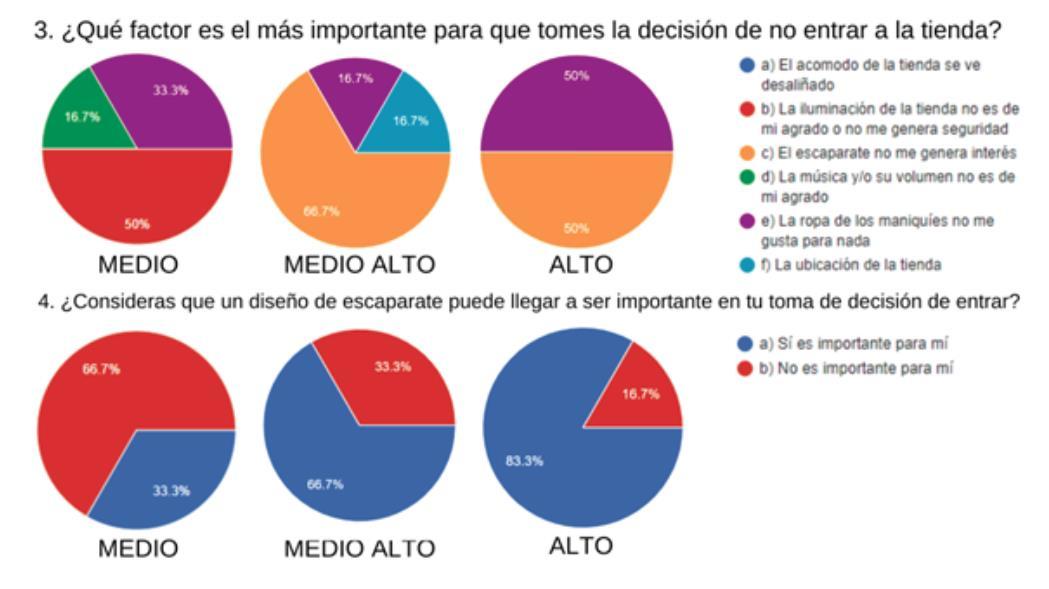
The second dimension will be characterized by intensity, that is, the level of involvement that people experience when in contact with the space, the product, the brand or the service, it can be a high level to the extent that interest is highlights or low if the opposite happens.
6 Blanco, Mercedes Investigación Narrativa: una forma de generación de conocimientos. En Argumentos, vol. 24, núm. 67, septiembre-diciembre 2011 pp. 135-156. México, UAM-X. 2011.
31 October 2022 Vol-17 No-10 Design for All Institute of India
Image 3. Example of application of the survey aimed at obtaining responses for the dimension of intensity. Personal file of the student: Rita Fernanda Cervantes León.
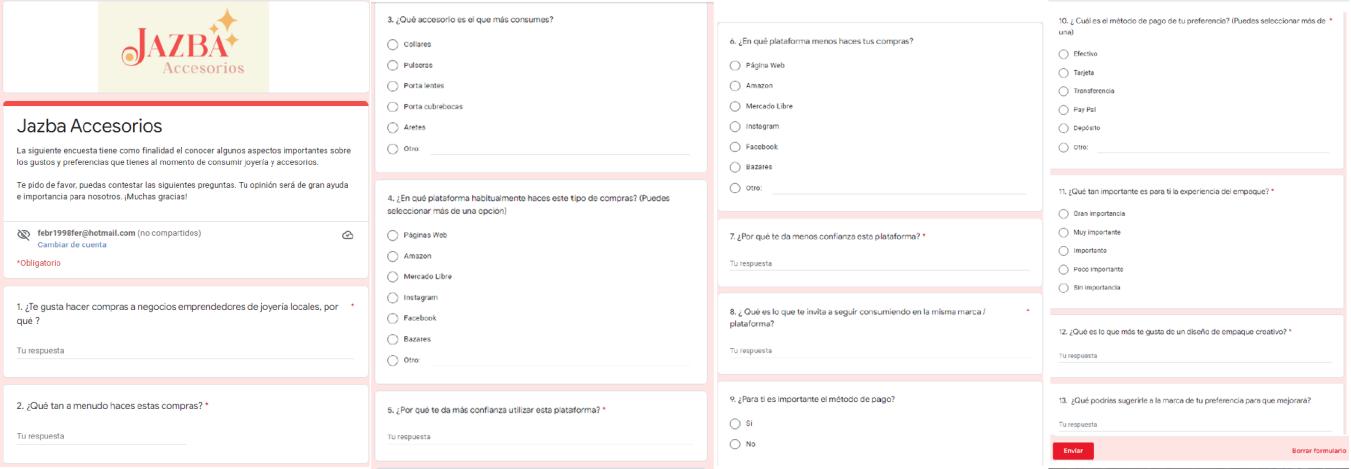
The third level of the experience is that of consistency, which is characterized by the interaction given between people at the level of the product, service, name, brand, promotion or price.
Undoubtedly, this dimension is linked to strategies from the world of marketing.
Image 4. Proposal for an assessment table of the consistency dimension. Personal file of the student: Ana Valeria Márquez González.
October 2022
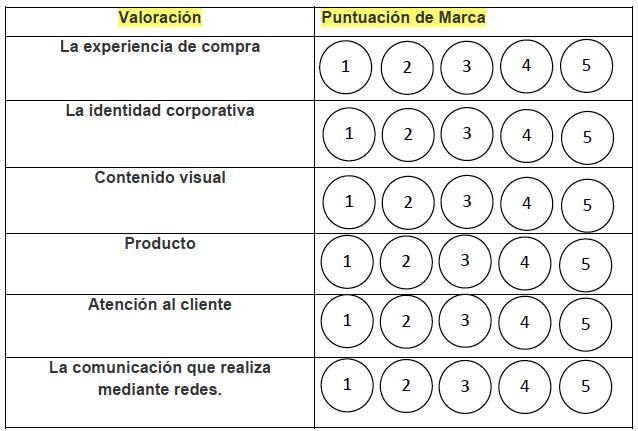
The fourth level of the experience is integrated by the meaning, for which it’s sought to identify the value or values associated with the space, the product, the brand or the service, all based on the emotions and reflections that the participants were able to express through various applied field research tools, in each particular case.
Image 5. Analysis of brands from publications on social networks, to determine the dimension of the meaning given from user comments. Personal file of the student: Ana Valeria Márquez González.

The fifth level of the experience is the interaction, this dimension is characterized by the way in which people are able to relate to the space, the brand or the service, for this it’s necessary to identify if said form of interaction it was passive, active or interactive. This dimension is particularly very interesting, since it’s influenced by many factors such as the distribution of the commercial space, if the product is within the reach of people, or if it obeys some particular intention identified by the brand itself based on some strategy proposal in order to promote the relationship with its users.
2022
Design for All Institute of India

The sixth level of experience is characterized by motivators. This level is especially rich and complex as it involves the analysis of aspects such as the concept, textures, materials involved, colors, images used, sound and smells. In this sense, the space, the product, the brand or the service, are oriented to polysensoriality and can provide a very wide range of information, constituting in itself, a whole study which requires experience to be interpreted correctly.
Image 7. Comparative table of application of color range of the brands analyzed to determine the dimension of motivators. Personal file of the student: Hilda de la Fuente Cortés.

Once the six dimensions that make up the analysis of the experience have been referred to, it’s important to emphasize that understanding the resulting experience will only be possible to the extent that information on the six dimensions is available. The
2022
Institute
India
2582-8304
correct evaluation of the experience is the product of the interaction and interrelation that is established in all the dimensions and not in the selection of some of them.
Image 8. Personal application of the experience model, identifying key aspects in relation to the particular case study. Personal file of the student: Pamela Ortega Solano.
36 October 2022 Vol-17 No-10 Design for All Institute of India

ISSN: 2582-8304
In order to obtain information on each of these-dimensions, it was necessary to design and apply field research tools,7, which could range from surveys to a specific profile of people, interviews 8 , photographic record 9 of commercial spaces 10 , products and publications in digital media 11 , non-participant observation 12 , assessment guides with Likert scales 13 , netographic research 14 , monitoring on social networks 15 and content analysis 16 of said publications.
7 Hernández, Roberto, et al. Metodología de la Investigación, México, Ed. McGrawHill, 2010.
8 Kvale, Steinar, La entrevista en investigación cualitativa, México, Ed. Morata, 2014.
9 Banks, Marcus, Los datos visuales en Investigación cualitativa, México, Ed. Morata, 2014.
10 Morgan, Tony, Visual Merchandising. Escaparates e interiores comerciales, Barcelona, España, Ed. Gustavo Gili, 2016.
11 Scolari, Carlos, Hipermediaciones. Elementos para una teoría de la comunicación digital interactiva, Barcelona, España, Ed. Gedisa, 2008.
12 Angrosino, Michael, Etnografía y observación participante en investigación cualitativa, México, Ed. Morata, 2012.
13 Méndez, Luz y Peña, José, Manual práctico para el diseño de la escala Likert, México, Ed. Trillas, 2006.
14 Hine, Christine, Etnografía Virtual. Barcelona: Ed. UOC. Colección Nuevas Tecnologías y Sociedad, 2000.
15 Ceja, Leobardo, Implicaciones discursivas del diseño en época electoral, en Responsabilidades del Diseño. Pertinencia en las prácticas políticas y sociales. México, Ed. Morevalladolid, 2020.
16 Barthes, R, Greimas A. J, Gritti, J, Morin, V., Metz, C., Todorov, T. & Genette, G. Introducción al análisis estructural de los relatos. En Análisis Estructural del Relato (10-22). Buenos Aires: Ed. Tiempo Contemporáneo, 1972.
37 October 2022 Vol-17 No-10 Design for All Institute of India
Image 9. Organization of the research process according to the particular case study. Personal file of the student: Irma Aurora Cerezo Salinas.
Image 10. The comparative analysis of social networks as a field research tool applied according to the particular case study. Personal file of the student: Mónica Paulina Camarena Navarro.
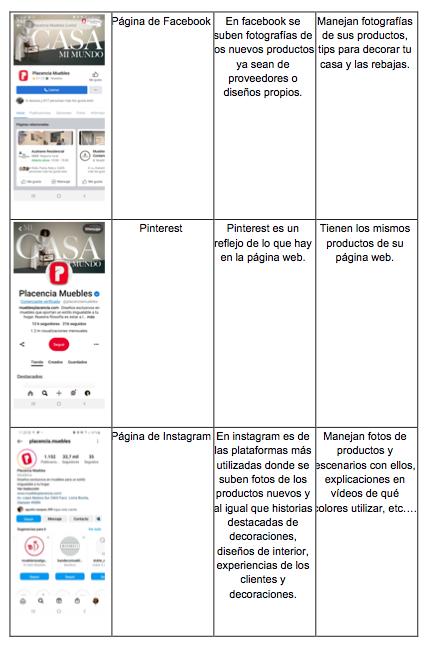

2022 Vol-17
All Institute
India
Achieving a broad, deep and far-reaching investigation is given by two key factors, the first of which is oriented on the combination of field investigation tools used to compile information and its subsequent tools used to compile information and its subsequent analysis, the second is oriented to the research itself, scheme proposed by Shedroff (2001), since said scheme serves as a route map, in whose follow-up it is possible to link the results of the research carried out. Therefore, the diversity of research tools that each of the students had to design for research constitutes an invaluable educational and investigative wealth and of which only a few small samples of said work are shown here.
Conclusion
Understanding the complexity of the prevailing current reality has required the use of all the research and information compilation tools that are within our reach, in that sense, the use of technology is a widespread fact, but we must bear in mind that “It’s not only that we use technologies to survive, but that we evolve in symbiosis with the technical cascades that formed us, and we are nothing without them.”17
The way in which some of the field research tools enunciated in this work have been applied; reflect the perspective and prevailing vision of the researchers involved, taking the experience model as a route map.
The richness of the model proposed by Nathan Shedroff constitutes an extremely interesting contribution. The reason for this statement is given thanks to the various dimensions proposed by the author.
17 Braton, Benjamin, La terraformación. Programa para el diseño de una planetariedad viable, Buenos Aries, Argentina, Ed. Caja Negra, 2021, p. 64.
October 2022 Vol-17 No-10 Design for All Institute of India
Likewise, each of the student projects shows richness, both in the application of various traditional research tools, and in the evidence that integrates said study.
The activities that we carry out can be considered as interactions and in this sense, they will be able to follow up from the trace, the footprint, the route taken, in this sense, it’s possible to have a certain narrative than can help to reflect on the actions, in this sense, the repercussions that this may have will undoubtedly be of a social nature, therefore, it will be pertinent to incorporate its dimension of effect, namely social, into any process involved.
Continuing to explore the forms of human interaction and the experiential effect involved constitutes an important challenge which must be assumed, since in a changing and hyperconnected society, the design of experiences and their social impact represent a way of reflecting on the social implication of design in its various fields18 .
Last but not least, it’s related to the integration of investigative processes related to the professional training of designers, in this sense, the work carried out by the students themselves is a sample of the strength, vitality and interest in the understanding of the people who are immersed in the various spheres of design, in this context, design experiences and their social influence, give an account of it in this course, being able to highlight the prevailing social commitment.
18 Important contributions within the Mexican context can be found with publications such as the one carried out by Ruth M. León Morán and Juan I. Michel Zepeda, They report in their work entitled Affectivity and design in the Mexican context: systemic models applied to the design of experiences, in Ortiz, Juan, (Compilador) Afectividad y diseño, México, Ed. UNAM, 2017.
40 October 2022 Vol-17 No-10 Design for All Institute of India
2582-8304
Gratitude
This work would not have been possible without the participation of each and every one of the students, who whit their questions, comments and contributions make any intention that one may have meaningful my gratitude for Perla Alatorre Caballero, Alejandro Damián Ángeles Andrade, Mónica Paulina Camarena Navarro, Irma Aurora Cerezo Salinas, Rita Fernanda Cervantes León, Aurora Chagolla Saldaña, Andrea Cortés Villaseñor, Hilda de la Fuente Cortés, Karla Estefanía Godínez Rizo, Diana Estefanía Hernández Méndez, Ana Valeria Márquez González, Paola de Jesús Oliva Martínez, Pamela Ortega Rosano, Danna María Ramírez Guardado, Arantxa Elizabeth Sánchez Carrillo, Ana Victoria Soler Laveaga, José Manuel Vargas García y Christian Imanol Zaragoza Velázquez. Likewise, I appreciate the interest, motivation and vision of the Program Coordinator, Master Juan Gabriel Herández Medina, since without his support these interactions would not have been possible.
October 2022 Vol-17 No-10 Design for All Institute of India
2582-8304
References
1. Angrosino, Michael, Etnografía y observación participante en investigación cualitativa, México, Ed. Morata, 2012.
Banks, Marcus, Los datos visuales en Investigación cualitativa, México, Ed. Morata, 2014.
Barthes, R, Greimas A. J, Gritti, J, Morin, V., Metz, C., Todorov, T. & Genette, G. Introducción al análisis estructural de los relatos. En Análisis Estructural del Relato (10-22). Buenos Aires: Ed. Tiempo Contemporáneo, 1972.
Becker, Howard, Para hablar de la sociedad la sociología no basta, México, Ed. Siglo XXI, 2015.
Blanco, Mercedes Investigación Narrativa: una forma de generación de conocimientos. En Argumentos, vol. 24, núm. 67, septiembre-diciembre 2011 pp. 135-156. México, UAM-X. 2011.
Braton, Benjamin, La terraformación. Programa para el diseño de una planetariedad viable, Buenos Aries, Argentina, Ed. Caja Negra, 2021.
2. Ceja, Leobardo, Implicaciones discursivas del diseño en época electoral, en Responsabilidades del Diseño. Pertinencia en las prácticas políticas y sociales. México, Ed. Morevalladolid, 2020.
Hernández, Roberto, et al. Metodología de la Investigación, México, Ed. McGrawHill, 2010.
Hine, Christine, Etnografía Virtual. Barcelona: Ed. UOC. Colección Nuevas Tecnologías y Sociedad, 2000.
Méndez, Luz y Peña, José, Manual práctico para el diseño de la escala Likert, México, Ed. Trillas, 2006.
October 2022 Vol-17 No-10 Design for All Institute of India
ISSN: 2582-8304
3. Morgan, Tony, Visual Merchandising. Escaparates e interiores comerciales, Barcelona, España, Ed. Gustavo Gili, 2016.
4. Ortiz, Juan, (Compilador) Afectividad y diseño, México, Ed. UNAM, 2017.
5. Scolari, Carlos, Hipermediaciones. Elementos para una teoría de la comunicación digital interactiva, Barcelona, España, Ed. Gedisa, 2008.
6. Shedroff, Nathan, Experience Design, U.S.A. Ed. Brand: Waite Group Press, 2001.
Kvale, Steinar, La entrevista en investigación cualitativa, México, Ed. Morata, 2014.
October 2022 Vol-17 No-10 Design for All Institute of India
Industrial Designer, Academic coordinator at Anahuac University of México, Board member in the World design organization and an Owner associate at NUB / furniture factory where she is a strategy consultant.

Is a PHD candidate in Critical Theory about "Social design experience", currently is studying a certificate in Disability Critical Theory. She has a Master degree in Contemporary art and a Speciality certificate in sculpture, drawing and art in Florence, Italy where she won different prizes as an artist and made individual and group exhibitions.
She had the opportunity to work as a designer in the industry and as a professor in several Universities and cities around Mexico. With experience in the Mexican design industry, government and manufacturing. She also worked in General Electric Energy for 5 years, obtaining different certifications in the meantime about quality and design. Also, was a Co-founder and organizer for various international conferences, talks and symposiums about art & design. Also was
2582-8304
invited as a speaker in several Universities and congresses nationally and internationally.
Her Design research and development expertise is in esthetics, symbolic meanings, manufacturing process, healthcare, disability, inclusion and sustainability.
Until today she is a writer about philosophy, art and design since 2008 at www.designforsociety.org
45 October 2022 Vol-17 No-10 Design for All Institute of India
Experience design and its relation to “disability”
Lilian González-GonzálezAbstract
The following text shows the process of developing the methodology of "social experience design" with examples of its application with students of industrial design, to generate meaningful, symbolic, metaphorical and instituting19 objects.
Keywords
Design experience, disability, singularity, symbolic, metaphor
Introduction
From the discipline of Design, how can we improve the quality of life of people in situations of chronic pain due to illness and disability? could these situations be addressed from their distinction, their accentuation, generate empowerment, and generate questions to help develop artistic and creative productions from these different ailments? Design can create devices or products for these users and facilitate experiences that help these living circumstances so that Design can go beyond function and aesthetics in objects to generate unique, meaningful moments that allow new experiences for the common well-being.
19 It is that which generates a rupture. See, (Mayer, 2014). “The Constituting is the different, the change, it supposes critical variation on the established. They are productive forces of new ideas and values”
This approach has been part of a creative process to generate a methodology that helps to address complex issues that are sometimes subjective and unspeakable—that help to create different results from the Design conceptualization.
Disability and the marginal, when treated as something that remains in the waste in the "other," is less important. This minority has been seen as the "sick" part of society that must be corrected and normalized. We can turn this around and see the marginal, those small villages, communities, and organizations that, although they are small and isolated or "marginalized," have the power to "protect," to "improve," and "teach" their forms of resilience, resistance, and survival, through practices that have even been millenary. What happens if we stop seeing the disabled and the marginalized as a failure and see them as potency? What can we learn from these bodies that have creatively solved their needs?
Body of the article
Design of the methodology
For five years in the Industrial Design Academy of Universidad Anáhuac México, we have been developing tools and teaching methodologies based on the "research through design'' method applied to undergraduate design students.
During this time, different processes and teaching tools were developed to generate a methodology that helps to "teach the design of meaningful experiences in complex situations", the solution was to add a previous step to the traditional design methodologies, in which mainly only the function, quality, and aesthetics were solved.
October 2022 Vol-17
Design for All Institute of India
In this proposal for the development of the projects that will be shown here, an additional step is added from the review and reference of some theoretical concepts that help to generate creative and conceptual developments. These concepts are:
The singularity
The symbolic
The metaphor
The instituting
Based on the review of these concepts, theoretical sources are suggested and reviewed to encourage the student's critical thinking, mainly through texts on philosophy, sociology, and art criticism, which are analyzed and discussed in the classroom to generate brainstorming, key concepts, which help to sensitize the student to address the issues raised.
Singular object; unique objects, generated for particular situations, objects that are discovered during the interaction with them, generate surprise, even estrangement, particular experiences to the users (Baudrillard and Nouvel, 2007).
Subjective object; it is endowed with a strong charge of meaning, sometimes fetishistic, sometimes magical, the symbolic object is powerful, it generates attachment, memory, even protest and is linked to the object it questions.
Metaphorical object; enables the production inside of the subject to manifest its interiority. Such an object can generate emancipatory
October 2022 Vol-17 No-10 Design for All Institute of India
processes; it even has the power to help enunciate, express, and to dislocate what otherness establishes in the individual.
Instituting object; it sustains novelty and rupture, an item that questions the one who interacts with it. The instituting mobilizes the established, generates fractures, breaking points; it is a stroke of change of meaning; it breaks with the norm.
Metaphorical objects; metaphor alludes to the thing, the thing of itself, which is inaccessible without metaphors. Metaphor is the only way to speak of everything that happens that is untellable or indescribable. It is the interface that helps us to reflect on what cannot be seen or heard.
The intention of reflecting on these concepts is to position the student in a different zone to observe the problem and thus look at the problem from another perspective. Theoretical sources, case studies of art, sociology, and philosophy help to have more rhetoricians and discursive resources in relation to the subject that will enrich the student to reach more creative solutions and interfere with the user in a deeper way.
The student enters a different terrain to that of his discipline, which can be uncomfortable and unknown; this helps to generate new solutions to existing problems and think from the singularity and subjectivity. The main objective is that the student can develop singular, symbolic, metaphorical, and questioning design proposals, which are the pillar concepts of the methodology.
October 2022 Vol-17 No-10 Design for All Institute of India
Another of the objectives of this is to generate opportunities to design "objects or devices" that can propitiate or facilitate the exchange of knowledge, reflection, and provocation through proposals that can stand out for their uniqueness, devices that facilitate meaningful experiences, activators of subjectivation and enunciation, power for people and even aspire to generate objects that can be emancipatory
Another critical point is to change the meaning of the residual and place it as the most important and not as what isn't essential or useless; by seeing it as the most important, the supposedly marginalized "minority" is placed in the center and is designed from the marginal.
By placing the different, the residual or in this case, the disability, in the center instead of in the periphery, it helps to generate new possibilities of technological objects and devices that can improve in a different way the quality of life of people, both the "marginalized" and those who have been seen as "normalized", to observe from the
See concept of emancipation in art, Benjamin, W. (2004). El autor como productor. (Itaca, Ed., & B. Echeverría, Trad.) México.

disability other problems for example, sharpens other senses and generates new possibilities.
In the discipline of Design, we must be concerned with the planning of meaningful experiences from the creative process to generate singular, symbolic, metaphorical, and instituting experiences, so that we can be able to generate important changes in culture and society.
The intention is to design "from" disability and not "for" disability. Here Design is seen more as a generator and facilitator of objects that provide empowerment to the user. This helps to give a new meaning to the so-called "inclusive design and universal design", which, although they have been extremely useful tools that have generated a design aware of "the difference, the different", should also evolve to be approached from new perspectives, as has been discussed throughout this article.
The project of prosthesis for children's hands and arms carried out by the design students (see image 1) starts off with the need to generate potentiality in children with amputations, empowerment from the prosthesis, and a device that can accentuate their singularity in a "positive" way. The function has already been previously solved by prosthetist specialists, so it is necessary to think about evolving towards a device that facilitates the enunciation of children with amputations, achieving to have a device of desire and not of rejection or replacement of the loss of the limb.
The simulation of a missing limb, only generates silence, discomfort, shame, pity, etc. Designing an object not as what is missing, but as an object of potency, of interdiction, of institution, of subjectivation,
Institute of India
2582-8304
an object that, in fact, must be differentiated and not fail in the attempt to "emulate".
The result of this exercise was a set of prosthetic hands which were very different from those on the market (see picture 3), with distinct functions, particular accessories, singular and different aesthetics and playful, which can motivate the child to use his prosthesis with dignity, and "desire" to show them instead of embarrassment or discomfort.
The following image shows the five main points that cover the proposed methodology at the end of the research and after a series of validations based on the application of different educational strategies to favor the teaching of social experience design. The methodology is a facilitator to generate critical thinking and thus be able to offer solutions with experience design and social impact.
Imagen 2, Outline of the methodology developed by Lilián González-González in her doctoral thesis: "Social experience design.”
October 2022 Vol-17 No-10 Design for All Institute of India

Image 3, arm prosthesis with adapters for multiple toys. students: Juan Carlos Alpizar and Ana Sofía Gonzalez. In image 3 the prosthesis is also a toy that empowers the child in front of the "other" who could judge him for the "lack of a limb", the child in this design drives him to want to talk to play and take him from the motor aspect to the psychomotor aspect (Levin, E. 2012).
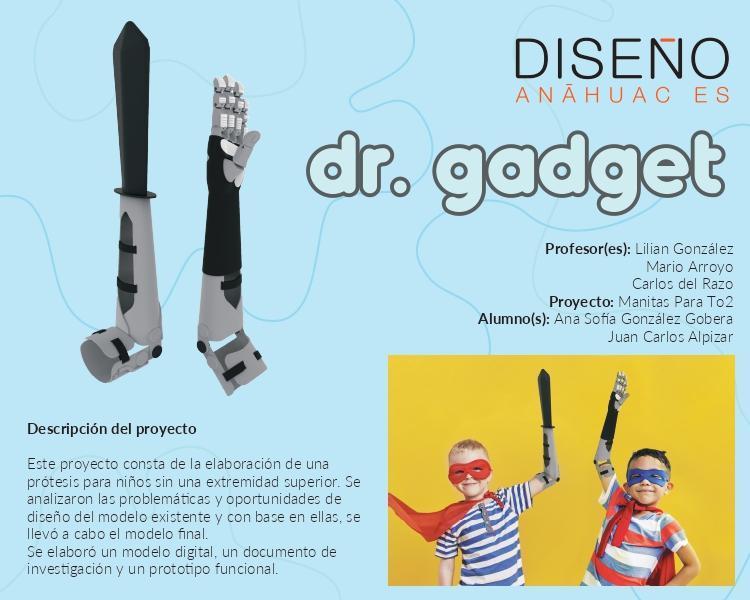
The possibility of generating, desiring and facing the other not as the "lesser" but as the "other" with different capacities and not only faults, this will make possible the poetization of the body and sublimate it in such a way that it finds itself and places its body as its own.
The interest of having design students work with these singularities is to take them to terrains that are alien to what the discipline is
familiar with, diverse terrains that destabilize them, that lead them to create singular objects and not objects of repetition or refinement, utilitarian objects.
Some design schools are highly focused on aesthetics, others on functionality, others on design engineering, optimization, and sustainability, and others rightly focused on interdisciplinarity, but on many occasions, remain on the surface of the design process or only in the enunciation and rarely in the event, that is, in the real application in the user's experience to generate a significant change. So, in the words of B. Mayer (2014), disability and interpellation could give the University a switch to the traditional teaching processes (Mayer, B., 2014).
The space of design students is not only a creative process in its conceptualization but also a process of creating tangible and pragmatic, singular objects/devices applied to real users and situations. Therefore, they move from abstract and critical thinking to creative and concrete thinking.
In conclusion, the Academy of Industrial Design teaches to design from disability, from the "different", the marginalized, from the not "normalized", from the different issues that do not find solutions in repetition and reproduction, but unique solutions, which although they can be replicable to similar situations, they are born from the difference and the particular 21 .
21 Véase video, González, Lilián (2019) para más referencias de proyectos de diseño.
October 2022 Vol-17 No-10 Design for All Institute of India
It is the minorities from which we can learn to design in a different way. If minorities are observed, we can find solutions that generate significant changes in the subject and in the culture. Design since the last century has been focused on the plural, on the masses, on the global, on repetition and replication. Why don't we make a turn of meaning and see the problems from the singular, from minorities, for example; from disability, from childhood, from the elderly, from migration, from war, from violence, from peace, from the "residue", (Mayer, B. 2014).
Society hides the differences due to fear of what is distinct, because it does not know what to do with that which does not fit into the canons of normality. This other should be eliminated, silenced because it generates noise; noise is annoying in a culture of pleasure and that only pursues happiness without suffering, without suffering, without feeling.
The society in which we live is patching/hiding the ugly, the strange, trying to beautify everything in its path, the city, the home, everything is susceptible to this fictitious beautification, simulacrum in the words of Jean Baudrillard (2007). It is necessary to exalt the difference, to enhance it so that it is just the point of leverage for its distinction, with pride.
October 2022 Vol-17 No-10 Design for All Institute of India
Image 4, design of prosthesis covers, students: Adriana Luengas and Feryeni González, link.
October 2022 Vol-17 No-10 Design for All Institute of India
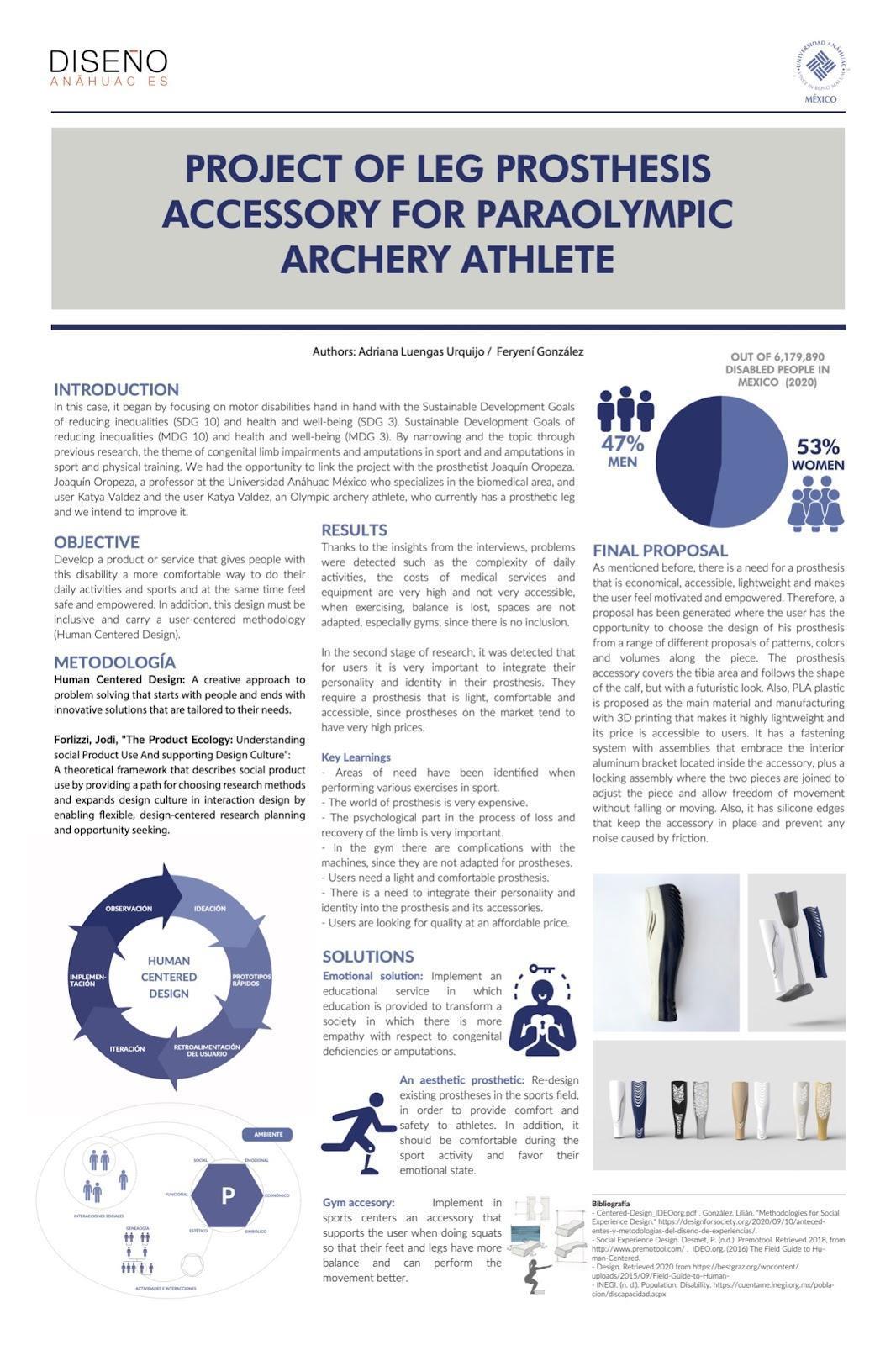
Image 5: Prothesis Before Design intervention
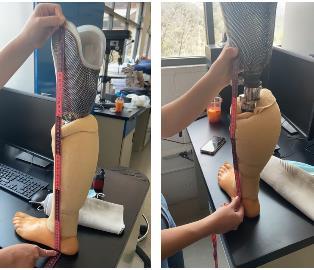
Imager 6: Intervened Prosthesis
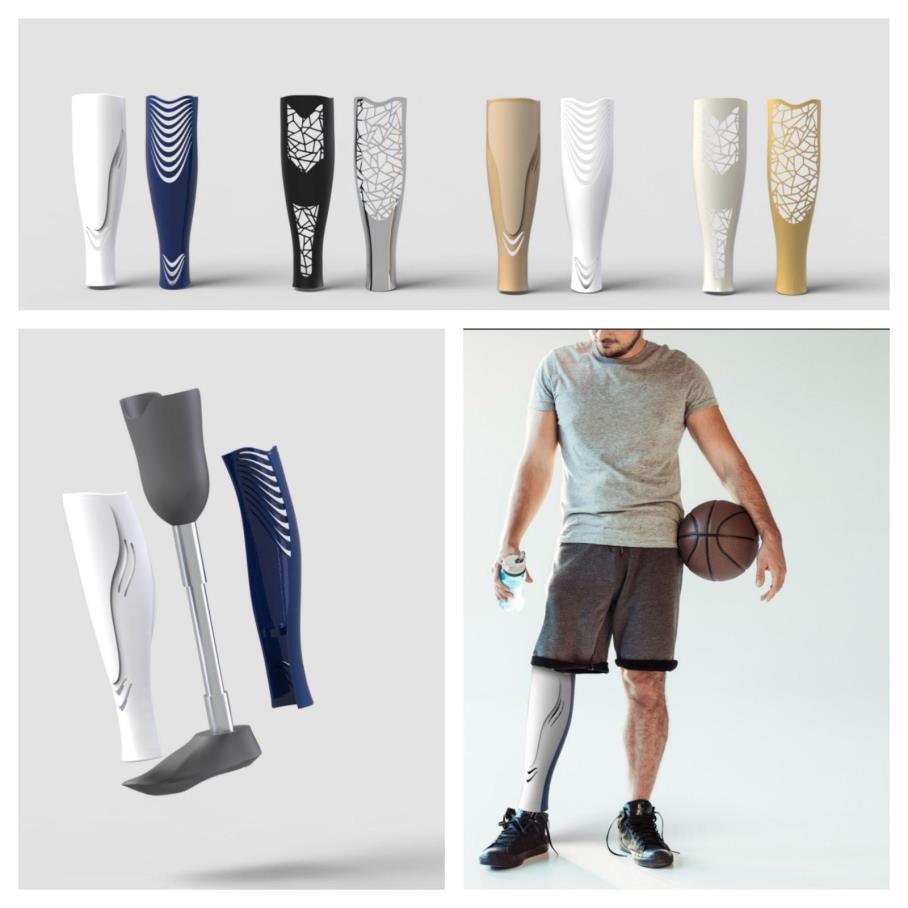
2582-8304
Bibliography
Buck Morss, S. (1981). Teoría y arte: en búsqueda de un modelo. Origen de la dialéctica negativa. Theodore Adorno, Walter Benjamin y el Instituto de Frankfurt (N. Rabotnikof, Trad.). México.
González-González, Lilian. (2022). Objects of well being. https://designforsociety.org/2022/06/14/objects-of-well-being-inthe-stages-of-pain/ González-González, Lilian. (2021). “ALTAR OF THE DEAD / MEXICAN´S RITUAL”
González-González, Lilián (2019). Student projects by Industrial Design Faculty at Universidad Anáhuac. https://www.youtube.com/watch?v=kWbXxkD5Afc https://designforsociety.org/2022/04/09/altar-of-the-deathmexicans-ritual/
Levin, E. (2012). Cap.4 “El niño y lo Otro”. En: Discapacidad, clínica y educación. Buenos Aires, Nueva Visión, págs. 73-88. Mayer, B. (2014). El Arte de Desaprender. Ponencia en Seminario Fundación Cisneros 2014. https://www.youtube.com/watch?v=RolNBVPKTV4
Mayer Foulkes, B. (2014) “El fotógrafo siega”, en: Mayer Foulkes, B. (comp.), El fotógrafo ciego. Evgen Bavčar en México, México,
Editorial Diecisiete (col. Diecisiete) / Conaculta.
Mayer, B. (2021). “La interpelación, en y más allá de la “discapacidad” ”: pedagogía, organización, virtualidad, economía.
58 October 2022 Vol-17 No-10 Design for All Institute of India
ISSN: 2582-8304
Ponencia presentada en línea el 19 noviembre 2021 en el Simposio "Discapacidad e inclusión interrogadas desde aproximaciones teóricas y prácticas sociales críticas", en el marco del XVI Congreso Nacional de Investigación Educativa, México, 2021. Está incluida en la Memoria electrónica, ubicada aquí: https://www.comie.org.mx/congreso/memoriaelectronica/v1 6/index.htm
Mayer, B. (2016). Necesitamos Instituciones Críticas con Mario Luis Fuentes [México Social].
https://www.youtube.com/watch?v=ua9df2PkUeY
Mayer, B. (2020). Conferencia Magistral—La “discapacidad” y la digitalidad.
https://www.youtube.com/watch?v=0Dc12VyGw8s&t=4891s
Pierre Vayer, (1997). El niño frente al mundo, Barcelona, Editorial científico-Médica, p.18
Nietzsche, F. (1873). Sobre verdad y mentira en sentido extramoral, trad. Pablo Oyarzún.
Baudrillard, J. y Nouvel J. (2007). Los objetos singulares. Arquitectura y filosofía. Fondo de Cultura Económica.
Norman, D. (2013). The Design of everyday things. New York: REVISED & EXPANDED EDITION.
59 October 2022 Vol-17 No-10 Design for All Institute of India
2582-8304
Jordan, P. (n.d.). Diseño y emociones. Retrieved 09 2018, from http://disenoyemociones.com/hablemos_de/diseno-yemociones2.html
60 October 2022 Vol-17 No-10 Design for All Institute of India
2582-8304
Angelica Garcia Estrada
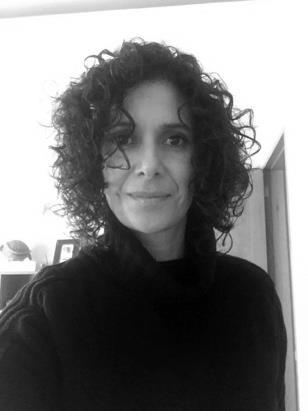
PhD in Physical Anthropology, Escuela Nacional de Antropología e Historia, Mexico
Master in Fine Arts, Kuntshogskolen I Bergen, Norway
Interests in the correspondence of art/crafts/design with anthropology.
Bachelor in Graphic Design, Universidad Autónoma MetropolitanaAzc Mexico.
Ceramist technician, Instituto Nacional de Bellas Artes, México
Professor at Universidad Anáhuac Mexico Norte and Universidad Panamericana Mexico.
Lecturer and Academic Writer
October 2022 Vol-17 No-10 Design for All Institute of India
Sensory ethnography as a methodology for an experience design
Dr. Angelica Garcia Estrada
Abstract
Knowing about the social groups is very important within design practice, especially with the growing interest in social design. For this purpose, it is essential to know the experience of people, emphasizing the emotional dimension, which is fundamental in all human experience. Emotions are the mediators of bodies; with them relationships are built and consequently societies themselves. An ideal research methodology that emphasizes emotions and the multisensoriality of bodies is the ethnography of the senses. This article incorporates knowledge from the anthropology of experience, the anthropology of emotions and sensory ethnography.
Key Word
Sensory ethnography, experience design, experiential bodies, social design
Introduction
The trendiest methodologies within design repeat again and again the importance of "experience" on one hand and on the other the idea that "the human is the center of design" but sometimes it seems that these two aspects are not fully understood. Why is it important to talk about experience at a time when it seems just like a trend? This is very evident in advertising not only of services but
also of products: What they sell are not the products themselves but the experience they can provide. However, on many occasions the experiences they reflect can be completely alien to our reality. Design methodologies continue to focus on products/services immersed within a market and what is worse, a market that is not understood or a foreign market. They also completely forget that it is about a "design for humans", even if the opposite is enacted.
Body of the article
I want to emphasize that we design for bodies, and I don't mean a set of bones, muscles, organs, something that is limited to ergonomics. Which bodies am I referring to? About bodies not only biological, but also cultural, social bodies, immersed in a context, that have a history. I would then like to talk about experiential bodies, because I consider that it is the most comprehensive way to approach the body. The body is the place where the experience of the world is actively live in.
I define the experiential body as "a field of sensory-affective perceptual experience of intersubjective, intercorporeal, therefore, collective relationships with the world that produces meaning and resistance" (García, 2021:34), a definition that comes from the work developed by Merleau-Ponty (1993), Csordas (1994), Citro (2009), Ramírez (2009), as well as Esteban (2013).
To address the experiential body, the contributions of the anthropology of experience22, the anthropology of emotions23 and
Turner (1986)
Breton (1999), Lutz & White (1986)
October 2022 Vol-17 No-10 Design for All Institute of India
the ethnography of the senses24 are fundamental because they deal with the sensory, affective and reflective dimensions of experience. They provide us with theoretical-methodological contributions that support that there is an embodied knowledge that transcends languages, is gestated with/from/in/through the sensitive, present in all human bodies and their experiences. For instance, there are activities such as trades in which it is difficult to explain their procedures in words. Such a case is that of the ceramist when she/he wants to teach her/his apprentice the processes of piece construction, no matter how much she/he highlights the different consistencies of drying clay and their names, the apprentice will not understand it, I mean, not with the body, until he feels the clay in his hands, its hardness, humidity, temperature, fragility, etc.
Bodies produce knowledge through body techniques (Mauss 1979) that involve gestures and movements and are expressed through the senses. In Western societies more emphasis has been placed on reason, and it has been argued that knowledge starts from thought, when in fact the first knowledge we have as bodies is gestated in perception. Bodies perceive the world and create that world. That is why it is necessary to be attentive to the multisensory world, always taking into account that the senses are built, they are not given by nature. This means that our perceptions as human beings are not universal but vary between cultures.
The perceptions that social groups have of their worlds in turn generate a series of emotions, which are also not universal: they are personal and social logics (Le Breton 2012). Emotions are
2022 Vol-17
All Institute of India
2582-8304
understandable through processes of construction of meaning (Ramírez 2012) and are recognized as an intrinsic part of the body. In addition, emotions are mediators of bodies, circulate between bodies (Ahmed 2004) so it is convenient to consider them within the collective sphere, especially if we have in mind a social design. That is why I propose to attend to emotions from anthropology, since the discipline studies human groups, unlike psychology, which looks at emotions individually. It is worth mentioning here that design as a discipline has been interested in emotions but generally using them psychologically to influence the user, or rather, the consumer.
Sensory ethnography
An ethnography is vital for the design of the experience since it aims to identify the meaning that people give to their experiences, to their being in the world.
The best way to get to know the bodies for which we are going to design is through contemporary ethnographies, especially an ethnography of the senses25. It is about thinking precisely about an ethnography that focuses in the senses, experience and its categories [Pink (2009)2015], attending to the knowledge produced within the bodies. In a sensory ethnography, the designer/ethnographer has to live in the context of people and be
25 In disciplines like History and Anthropology the “sensory turn” began in the 80s. Since then, several authors have made research around it, like David Howes (2005). Sarah Pink brought the term "sensory ethnography" [(2009)2015]. In Latin America Silvia Citro and team have been working for almost four decades with ethnographies that attend to the senses and perception, proposing an ethnography "of and from" the bodies (Citro 2010).
65 October 2022 Vol-17 No-10 Design for All Institute of India
2582-8304
aware to everything they feel-think-say and do 26 . It involves participant observation, and going further, a "participant perception" [Pink (2009)2015], an ethnographic interview or indepth interview, and another series of techniques that can be adapted in the context and vary according to specific projects.
In the words of Sarah Pink, "ethnography is a reflective and experiential process through which knowledge is produced" [Pink (2009) 2015:4]. Sensory ethnography goes towards deeper knowledge, that knowledge that resides in bodies but can be inaccessible with a mere observation or an interview. The "participant perception" proposed by Pink, therefore, advocates that the ethnographer use his whole body and sensoriality in the field as a source of reflection.
There is no step-by-step methodology, the designer/ethnographer will eventually have to make adaptations along the investigation. However, the most important points are:
1.Being in the context. 2. Approach to it in a multisensory way, paying attention to the smells, colors, shapes, temperatures, etc. Sense the spaces but also the objects that inhabit them. 3. Do an indepth interview with the people who are going to be part of your study, repairing in verbal and non-verbal language, body attitudes, all the gestures they may have. As for the verbal part, be aware of
26 Hermeneutic circuit that "shows that the body-subjects respond to their circumstances in cognitive, emotional, discursive and actancial ways; in addition, it is a form of technical visualization that allows the understanding of the body in its being, and is proposed to evoke the descriptions and metaphors that are capable of transforming the experiences of the body in a pre-reflective mode of information, in a language as a digital mode of information and in action as the flat realization of subjective interaction " (Ramírez 2016b: 116)
66 October 2022 Vol-17 No-10 Design for All Institute of India
everything that is said but also of everything that is not said, that is, the silences, which often say more than a thousand words. Always have in mind that we are interested in knowing what is meaningful to people and why. Here the emotional dimension is fundamental. 4. The reflective and interpretative part is very important, remember to reflect with the body. Write down everything that the body perceives in relation to the people you are interviewing. Make a record (video, audio, drawings, photographs, other resources) of what people feeldo-say-think and above all, again, what it means to them. 4. Cocreation. How can you create something together with the people in your research? You can make a reflection in conjunction and propose ideas.
The experiences of the bodies that you study are a source of knowledge. Remove a colonialist attitude. It is vital to be aware that the role of the designer is not to influence the behaviors of individuals, rather the opposite: starting from their behaviors, which are knowledge, we can improve design practices, social design and emotional design. Knowing better how people eat, talk, dance, work, etc., we can design objects or spaces that actually can enhance those experiences which are meaningful for them.
Conclusion
A very powerful tool for experience design is precisely the analysis of people's experiences, that is, the inquiry of experiential bodies, through an ethnography of the senses. Through the senses we can understand the being-in-the-world of the bodies, how they relate between each other, between their objects and their spaces.
October 2022 Vol-17 No-10
for All Institute of India
ISSN: 2582-8304
References
Ahmed, S. (2004) Teoría Estética. Madrid: Ediciones Akal
Csordas, T. (1994) Embodiment and Experience. The Existential ground of culture and self. Cambridge: Cambridge University Press
Citro, Silvia
2009 Cuerpos significantes. Travesías de una etnografía dialéctica. Buenos Aires: Editorial Biblos
2010. "La antropología del cuerpo y los cuerpos en-el-mundo. Indicios para una genealogía (in)disciplinar" in Citro S. (coord.) Cuerpos plurals. Antropología de y desde los cuerpos. Buenos Aires: Editorial Biblos, pp 17-58
Esteban, M.L. (2013) Antropología del cuerpo. Género, itinerarios corporales, identidad y cambio. Barcelona: Ediciones Ballaterra.
García, A. (2021) La doble precarización en las prácticas artísticas: análisis de los cuerpos sensibles y en resistencia de un grupo de mujeres artistas visuales en la Ciudad de México. Tesis doctoral. ENAH.
Howes, D. (ed)(2005). Empire of the Senses: the sensual culture reader. Oxford:Berg.
Le Breton, David
1999 Las pasiones ordinarias. Antropología de las emociones. Buenos Aires: Ediciones Nueva Visión
2012 “Por una antropología de las emociones”. Revista Latinoamericana de Estudios sobre Cuerpos, Emociones y Sociedad. (10)4, Argentina, pp. 69-79
Lutz, C., White, G. (1986) The Anthropology of Emotions in Ann Rev Anthropol 15:405-436
Mauss, M. (1979) Sociology and Psychology: Essays, tr. B. Brewster. London: Routledge and Kegan Paul
68 October 2022 Vol-17 No-10 Design for All Institute of India
ISSN: 2582-8304
Mearleau-Ponty, M. (1993) Phenomenology of perception. Buenos Aires: Planeta-Agostini
Pink, S. (2009)2015 Doing Sensory Ethnography, 2nd ed. London: Sage Publications. Ramirez, Josefina
2009. “El reto de pensar la perspectiva cualitativa aplicada a la Antropología Física”, Estudios de Antropología biológica, 14, pp. 479-505
2012. “Cuerpo y emociones. Un nuevo horizonte para la comprensión del sujeto en Antropología Física”, Diario de campo, 10, pp. 22-27
2016b “Las emociones como categoría analítica en Antropología. Un reto epistemológico, metodolótico y personal”, en López, O. y Rosas, R. (eds) Cartografías emocionales. Las tramas de la teoría y la praxis. Ciudad de México: Universidad Nacional Autónoma de México, Facultad de Estudios Superiores Iztacala, pp. 97-126.
Turner, V. and Bruner, E (ed) (1986) Anthropology of Experience University of Illinois Press
69 October 2022 Vol-17 No-10 Design for All Institute of India
JOSE HECTOR LOPEZ AGUADO AGUILAR México – 1957
Industrial designer with a master degree in Design and innovation with focus in Strategic Design.
Currently Director of Artefactum, Servicios de Diseño, a design studio and Blepsvision, a company dedicated to improve visual health and care.
He was Coordinator of CIDI (Centro de Investigaciones de Diseño
Industrial, Research Center for Industrial Design ), at the Architecture Faculty of Universidad Nacional Autonoma de Mexico
( National University of Mexico ) and also headmaster of the Design School of Universidad Politécnica de Nicaragua (Polytechnic University of Nicaragua). Currently teacher at the National University of Mexico, Universidad Anahuac and Universidad Autonoma de Queretaro .

He has participated in different design projects with several universities and companies around Mexico and USA.
He has also published several articles about design and interaction in different media.
He was president of DI INTEGRA, a nonprofit organization that gathers Mexico's most important industrial design schools.
The social game Physical activity vs exercise
JOSE HECTOR LOPEZ AGUADO AGUILARAbstract
The benefits of physical activity are well known, however, getting people to do it consistently and efficiently is a serious problem. The promotion of physical activity is not a simple goal, there are multiple ways in which it is pursued, from physical education classes in the SEP (Ministry of Education) programs, to the installation of outdoor gyms in Mexico City.
On the other hand, a person with a sedentary lifestyle suddenly launching into moderate-high intensity physical activity for long periods if they have never done it before can backfire, as it could lead to injuries and an overall negative experience.
At least 30 minutes of regular, moderate-intensity activity on an almost daily basis is recommended (WHO, 2004); it seems simple, however in Mexico the people who report insufficient or null levels of physical activity are close to 50% (INEGI, 2018), the most cited causes for not doing physical activity are lack of time and fatigue from the working day (INEGI, 2018).
Most of the campaigns and studies about physical activation focus on exercise routines, walking or running, they do not consider the
2582-8304
motivations and lifestyle of some people. A broader, more inclusive, and integrated approach to understanding and promoting human movement is thus required to better address the current public health crisis (Chaput, Carson, Gray, & Tremblay , 2014).
How to integrate motivations with lifestyles to contribute to health without becoming an obstacle throughout the day?
An alternative could be video games, since they arouse and maintain the interest of the players, so they can be allies so that the acquisition and maintenance of new habits is enjoyed, in particular the so-called exergames, which combine exercise and video games, use the engaging experience of playing a video game to help people achieve their exercise requirements.
Keywords
social game, exergame, group collaboration, physical activity
Introduction
Different articles talk about the concept of adherence that is developed with exergames, which is achieved by promoting collaboration in groups and avoiding the obligation to exercise during specific periods and times, that is, the opposite of what is done in traditional gyms.
Social gaming offers specific benefits such as concentration and a good state of mind for players, as well as the acquisition and maintenance of habits.
October 2022 Vol-17 No-10 Design for All Institute of India
2582-8304
The importance of offering a balance between the challenge level of the game and the skill level of the player, and constant feedback during the game must be emphasized in order to have positive results.
Body of the article
Design is a proposal to increase physical activity that considers the motivations, lifestyles and scope necessary to have a positive impact on health and lifestyle without becoming an obstacle to said lifestyle.
The solution then should be:
● Facilitate the performance of physical activity that is perceived as an entertaining activity that can be performed in short intervals and can be accumulated during free time.
● Increase physical activity of medium intensity in cumulative intervals, relying on elements of play and social cooperation to achieve this, also promoting community interaction.
● Achieve physical activity of moderate intensity in minimum intervals of 10 minutes.
● Integrate video game elements to promote a state of flow, a positive perception of the task, cooperation between members of a community and the fulfillment of dynamic goals. Lifestyle and obstacles
The initial focus should be opposed to an individual activity. That is, it must be started considering the advantages that group support grants in achieving goals.
October 2022 Vol-17 No-10 Design for All Institute of India
Therefore, the adaptation of video game dynamics should be considered to get a community to play in their free time as the main objective, having as a collateral result the performance of physical activity and the construction of positive associations with physical activity in the process.
Understanding the human factors of the performance (or not) of physical activity will allow a viable proposal in factors of function, production, aesthetics and ergonomics that complement the approaches of health and sports.
Why do physical activity and not exercise?
The World Health Organization defines physical activity as any bodily movement produced by skeletal muscles, with the consequent consumption of energy. This includes activities carried out when working, playing and traveling, household chores and recreational activities (WHO, 2018).
Physically active people have a better physical shape, a lower risk profile for various disabling conditions and a lower rate of chronic non-communicable diseases.
Adults 18 to 64 years old should accumulate a minimum of 150 minutes per week of moderate aerobic physical activity, or 75 minutes of vigorous aerobic physical activity each week, or a combination of moderate and vigorous activities. Aerobic activity will be practiced in sessions lasting at least 10 minutes (de Pablo and Zarzosa, nd), (WHO, 2010).
2022 Vol-17
Design for All Institute of India
The city and our lifestyles make it difficult to incorporate physical activity into daily life. Physical inactivity is becoming more widespread in many countries, and this has a considerable impact on the general health of the world's population, on the prevalence of Non-Communicable Diseases or NCDs (for example, cardiovascular diseases, diabetes or cancer) and on their factors, such as high blood pressure, excess blood glucose, or being overweight. Physical inactivity is estimated to be the main cause of approximately 21–25% of breast and colon cancers, 27% of diabetes, and approximately 30% of ischemic heart disease. Furthermore, NCDs currently account for nearly half of the total global burden of disease. It has been estimated that six out of every 10 deaths are attributable to non-communicable diseases (WHO, 2010).
In Mexico, of the physically active population, 52.4% reach the level of sufficiency to obtain health benefits according to the recommendations of the WHO (2004), depending on the frequency, duration and intensity of physical-sports practice. 44.6% of the physically active population is exercising with a lower level than recommended (INEGI, 2018).
According to the WHO, the physical activity of young people is declining worldwide. It is estimated that more than two thirds of young people do not have enough physical activity to benefit your current and future health and well-being. Children walk or bike to school less and less and spend too much time watching television and using the computer, often at the expense of time spent on physical activity and sports. Physical education and other physical activities performed at school are also declining (WHO, nd). In
2022
Design for All Institute of India
adulthood, levels remain low due to insufficient participation in physical activity during the time and an increase in sedentary behaviors during work and domestic activities. The increased use of passive means of transportation has also reduced physical activity (WHO, nd).
However, early adulthood can also be a period when people are especially receptive to advice about taking regular exercise. The period between the ages of 18 and 25 is characterized by change, exploration, and the adoption of lasting lifestyle options (Rovniak, Anderson, Winett & Stephens, 2002), and physical activity can contribute to social development of young people, giving them the opportunity to express themselves and encouraging confidence, social interaction and integration, as well as greater ease in adopting other healthy behaviors, such as avoiding tobacco, alcohol and drug use, and having better school performance (WHO, nd).
Improving physical activity in young people is essential for the future health of the entire population (WHO, nd).
In addition to the general benefits of regular exercise, intervals of as little as 10 minutes of moderate-intensity exercise have been shown to show punctual (short and temporary) cognitive benefits in working memory, concentration, and mood. That is, if done three times a day, people doing 10-minute intervals of physical activity could not only reap the benefits of a continuous 30-minute block of exercise, but also improve their focus, concentration, and mood over time. length of the day (Gao & Mandryk ,2012). Another benefit of moderate physical activity is the decrease in the possibility of injuring yourself when doing it.
October 2022 Vol-17 No-10 Design for All Institute of India
Communities
For a community to actively participate, the location for an exergame must be in a place that is frequented by all members regardless of the time of day they do so, so that everyone can contribute to the group benefit. Schools or offices are spaces that meet this requirement. What is important is that it be a common place of transit for all the areas or departments involved so that they can play in their free time or at different times between their activities.
The idea of integrating mechanics that encourage physical activity at various intervals throughout the day to combat sedentary behavior can be beneficial. Simple activities like climbing stairs or walking down hallways are easy ways to build up time spent on physical activity. The important thing is the registration of it as well as the intensity, duration, modality, and environment where it is carried out.
Moderate physical activity also has the advantage of avoiding the pain associated with exercising, which is convenient for those who are just starting out in physical activity.
A well-documented barrier to continued participation in physical activity refers to the lack of pleasure derived from community participation and goal achievement.
The perception of pleasure is associated with the achievement of goals, a sensation that is known as the autotelic experience, which is experienced when the activity is highly rewarding. For this to happen, the flow state must be reached.
All Institute
India
Video games and exergames
In a game where the challenges and goals are structured according to the skill level, the player will be able to achieve the state of flow since the goals and challenges are appropriate according to the skill level, neither too easy nor too difficult, which allows him/her to advance according to the skill acquired. That is, the so-called autotelic experience is achieved where the reward obtained is derived from the very act of performing the activity.
Unlike exercise, in a video game the feedback is immediate, which constitutes a motivation to continue and advance since the achievement reached and the level to be overcome are known exactly. In a video game the reward is immediate and visible. Also the rules are simple.
In order to achieve the recommended daily goals, it is necessary that the exergame provides a sufficient level of aerobic activity to provide benefits.
Sense of belonging
Group interaction has an influence on individual behavior, from which it can be deduced that playing in a group helps not to abandon the game and maintain the necessary adherence to achieve health benefits, the above plus camaraderie and intrinsic fun become motivations to continue with the activity associated with the exergame. Proof of this is the rise of online group games. In short, the activity should be enjoyed.
Music and rhythm
It is human to associate rhythm with movement. Music is one of the elements common to all mankind. It is capable of generating positive moods and distracting us from the tiredness caused by physical activity. It can be evaluated, if it is possible to synchronize the rhythm and movement of parts of the human body, therefore feedback can be given on the results and the level of synchrony achieved. If full synchronization is not achieved, the need to retry is felt until success is achieved.
Beat is an exergame proposal developed by Jenny Reza Arteaga , a student at the Industrial Design Research Center (CIDI), proposed for the student community of that school, that considers the following factors to encourage physical activity. The elements associated with the flow state:
Challenge-skill balance
Action-awareness fusion
Clear goals
feedback
on the task at hand
-awareness/disinhibition
October 2022 Vol-17 No-10 Design for All Institute of India
Other aspects taken into consideration for its design are the following:
Positive emotional experience
Social experience
Moderate intensity physical activity
10 minutes long
Availability
These elements make it possible to ensure that the objective of getting people to perform physical activity, without the obstacles usually associated with doing so, is met.
fig 1 Beat exergame
In the proposal of this exergame, the casual game style, simple game dynamics, popularity and movement stimulation of rhythm games were used to modify and control the intensity of physical
2022

2582-8304
activity, while the simplicity of the game allows players to get acquainted quickly an increase of the intensity in the physical activity at higher level, without increasing the complexity of the game dynamics can be achieved, so that the balance between challenge and skill prioritizes physical fitness, and not the ability to play a video game. The appeal was maintained by speed increases and not dynamic changes, as in Tetris, and the ability to keep up with the game and continue a winning streak without errors, as in the Flappy Bird game.
By adhering to the flow elements and adding the rhythmic and social elements, players are intended to be intrinsically motivated to play, because they enjoy it, and this enjoyment of the game and physical activity provides a positive emotional experience regarding to the intensity of the activity (with the correct balance of challenge-skillfeedback), so that the challenge keeps the game attractive and effective, turning Beat into an autotelic activity (performed by itself) that motivates intrinsic (enjoyed) supported by social coexistence.
Beat offers short bursts of physical activity of varying intensities throughout the day, and encourages the player to stay and play with friends and gradually increase the intensity/difficulty of the game by providing clear challenges and feedback on their progress.
It consists of a screen that serves to visualize the current status, feedback to know the progress during the game. It is connected to a mat with two clearly defined spaces for one or two people to position themselves, which allows you to play individually or in pairs.
October 2022 Vol-17 No-10 Design for All Institute of India
It is proposed to be located at the access area to the facilities, in one of the corridors with the highest flow of people, but with enough space not to obstruct circulation.
The social game will be achieved in two ways, one more immediate than the other: the first consists of cooperating with their classmates to achieve the common goal of obtaining a higher score than the others (which will be achieved with more game time in more complex levels).
This cooperation-competition will also be used to arouse curiosity and encourage students to play, since the classification of the generations will be shown as a waiting screen between players.
The second has to do with the very installation of the game in a social and common space, in addition to promoting competition or cooperation by awarding a higher score when two players play instead of one, regardless of whether they are of the same class (cooperate), or a different one (compete). At the end of the game,
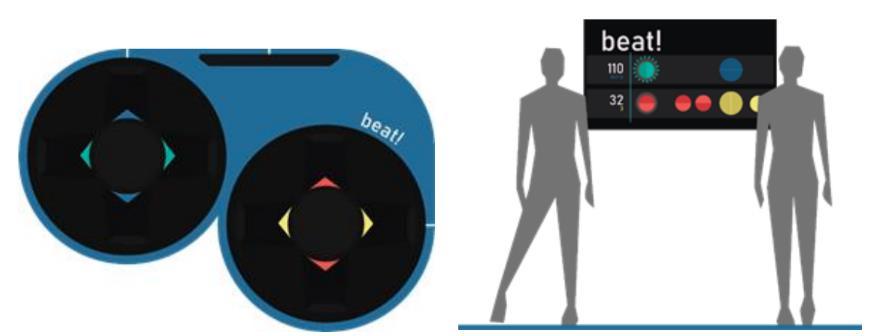
the individual scores are added to the collective score, and the player is suggested to select a level of greater/lesser difficulty or repeat the same according to their performance.
Conclusions
Beat keeps a simple game dynamic. Adjusts between different levels of intensity of physical activity in an efficient way, when changing players. Arouses and maintains the interest of the players, promoting adherence.
It facilitates the performance of physical activity and that it is perceived as an entertaining activity that can be carried out in short and cumulative intervals during free time.
Allows physical activity of moderate intensity in minimum intervals of 10 minutes and also integrates video game elements that promote a state of flow, a positive perception of the activity carried out, cooperation between groups in a community (in this case the different generations) and the fulfillment of dynamic goals as well as immediate feedback and recommendations.
Beat is an example of the way in which design can contribute to solutions to complex problems for the benefit of different social groups.
October 2022 Vol-17 No-10
for All Institute of India
ISSN: 2582-8304
References
Chaput, J.-P., Carson, V., Gray, C., & Tremblay, M. (2014). Importance of All Movement Behaviors in a 24 Hour Period for Overall Health. International Journal of Environmental Research and PublicHealth, 11, 12575-12581. doi:https://doi.org/10.3390/ijerph111212575 de Pablo y Zarzosa, C. (s. f.). Ejercicio aeróbico o anaeróbico, ¿cuál es el mejor para tu salud? Recuperado el 20 de agosto de 2020, de Fundación Española del Corazón: https://fundaciondelcorazon.com/corazon-facil/blog-impulsovital/2654-ejercicio-aerobicoINEGI. (noviembre de 2018). Módulo de Práctica Deportiva y Ejercicio Físico (MOPRADEF). Obtenido de Instituto Nacional de Estadística y Geografía (INEGI).: https://www.inegi.org.mx/contenidos/programas/mopradef/doc/r esultados_mopradef_nov_2018.pdf
OMS. (2004). Estrategia mundial sobre régimen alimentario, actividad física y salud. Obtenido de Organización Mundial de la Salud: https://www.who.int/dietphysicalactivity/strategy/eb11344/strate gy_spanish_web.pdf?ua=1
OMS. (2010). Recomendaciones mundiales sobre actividad física para la salud. Ediciones de la OMS. doi:ISBN 978 92 4 359997 Rovniak, L. S., Anderson, E. S., Winett, R. A., & Stephens, R. S. (2002). Social cognitive determinants of physical activity in young adults: A prospective structural equation analysis. Annals of Behavioral Medicine, 24(2), 149-156. doi:https://doi.org/10.1207/s15324796abm2402_12
84 October 2022 Vol-17 No-10 Design for All Institute of India
Letter from the Chairman’s Desk By Sunil Bhatia PhD

One day my mother kept a vessel filled with milk for boiling over the gas burner and in between she thought to perform minor work in the kitchen. It is human nature of performing multi-tasks and she was the victim of that habit and could not focus for a while on boiling milk. Suddenly she noticed boiling milk was about to come out of the vessel. She was about to switch off the gas burner but time was short so she tried to take the vessel out of the flame by holding the attached handle of the vessel. She managed and sighed in relief. This safety feature helped in preventing the spilling of the boiling milk and avoided any possible eventuality. Since emotions influence decision-making. her emotion of not wasting the precious milk but her diverted attention affected, but her memory of vast experiences helped in action for best suitable meaning.
I witnessed that incident but could not help her because I was standing at some distance. Designers should remember that visualized users perform their actions in such a way in advance that will help in associated pits and falls in advance. This exercise will help in generating the desired designed emotions in their users. The moment I saw the milk boiling, my first reaction was to warn her by shouting and my next action was to run to turn the gas knob off. Time was very short and before I came to the action my mother
Institute
India
acted wisely and prevented the situation from going worst. I was behaving as a designer who was not present in the scene and my mother as the user who was performing tasks and facing consequences. At that moment I realized who so ever has thought of attaching a handle to the vessel was a highly emotionally charged person and helped his/her dears for avoiding any kind of burn injuries. It may treat as a safety feature for users but I say it is an emotional design that guides them to think for such a design. In this case the introduction of the handle makes the designer present in the kitchen of the users as and when he uses that vessel. The introduction of using the cotton napkin as an insulator for avoiding burn by holding it from the brim to taking the hot vessels out of the fire was a safety feature invented by users but attaching a handle as a permanent feature is an emotional design along with safety. There is no need for wasting the time looking something for to take out from the fire by holding. It is an inbuilt feature. Later on, it is known as product differentiation in marketing terms by adding extra features for consumers.
One disciple questioned his master “What is the most important thing in your life?” His master replied after giving proper thought to his question and answered “ it was the love of my mother that made me survive. It is her emotion for me that made me what I am at present. The entire universe is functioning because it is on the emotion of love. Even every animal kills the prey, not in hatred but to satisfy hunger and the prey is aware of that feeling of the attacker but it is the inbuilt emotion of life that made them live longer and struggled hard with all mighty forces to come out of that clutches for survival.
2022 Vol-17 No-10
for All Institute of India
I noticed in my house that my mother was taking special care of the specific dress and when I asked her she said it is a lucky charm for me and gifted by your grandmother. It appears to be an ordinary dress but it was a special emotionally attached dress for her . When I passed the high school examination that very moment my father gifted me his wrist watch and he is no more but that watch is still close to my heart and prized possession. The design of a spoon or comb never creates special emotions because there is no scope for improvement in it .Spoon is designed for avoiding using our hands for hygienic eating and avoid hot/cold burn of fingers. Similarly, a comb is required when we feel for using it. But designing a specific tying of hair that is liked and appreciated by others creates an emotional design and women prefer to design their hair in the same manner that is appreciated by others.
Emotions play a very great role in our decision-making. I have witnessed certain boys or girls deep in love to that level that they are ready to sacrifice their life for each other. Even if someone did not get that person as a life partner they never marry anyone throughout life or someone dies after marriage she/he spends her/his entire life without marrying anyone. That emotional strong bonding is in every human. The same bonding turns to negative emotions and plans for killing those who have betrayed. In product designing, the designer introduced emotions through special features that have no functional value but help in arousing emotions. A king chair has a lion mouth at the arm handle that establishes his authority. A chair with red color expresses the special treatment of the person occupying it. A student sits on a simple chair and using the same every time develops the emotion that quickly sets his focus
2022
for All Institute of India
mind for learning. Someone sitting on a chair kept on the raised platform makes him special and others are normal humans. When someone sends a greeting card on a father's or mother's or grandparent's day is an emotional design. Tying a band on the wrist of someone who is very close to your heart in expressing a gesture of friendship is an emotional design. But using the wristwatch is a functional and convenient design. If someone forgets to use wrist watch and regrets that it is a habitual design because he faces some difficulty in performing the task without a watch like a doctor feels handicapped while examining patients with a stethoscope to count heartbeat or pulse. When a wristwatch gives the prized possession and indicates your social status then it turns into an emotional design.
When I read that expert designers are focusing on product differentiation for measuring the level of emotion associated with the products by comparing a similar product with minor product differentiation that appears ridiculous to me. It is the emotion that is the dynamo of creating differentiation. If the designer is passionate about designing the product his emotion will be clearly reflected in it but if the designer is paid for designing and has a rational mindset his design will be completely different. It is the degree of passion and emotion that creates differentiation. Another important factor is as long there is scope for improvement in products it has the association of emotion of designers and as it reaches the ultimate where the scope of design is only in terms of material improvement is left but not in design loses its emotional quotient. Each user has their own story about the product and how that trigger makes the level of emotion with it. It surfaces who has gifted or that product
October 2022 Vol-17 No-10 Design for All Institute of India
reminds and triggers the emotion of the associated person as he encounters the product.
I called the death an incident but it is the memory that reminds you how you have spent time and what the level of association that deeply affected your life generates a different degree of emotions. Have you ever heard anyone crying for unknown dead body possession? It is the associations that pinch that person are no more. I cannot associate the people who died in a plane crash with whom I have never had the opportunity in my life to interact in any manner. It will be simply a news item for me.
When an individual sits in front of the mirror for dressing and makeup is an exercise to trigger good feelings in people who are
encountering and appreciating. That appreciation emotion plays to the family level where the house owner keeps every product in order for proper functionality but decorates the house for enhancing aesthetic sense for triggering the appreciation and good feelings of those who are living as well as who are visitors. Dust and its microbes lower good emotions and generate negative emotions.
Anger, hatred, frustration, and other similar emotions are negative and appreciation, and love is positive motions. Both emotions are required for designing the products. Lawyer frustrates by his questions to the accused for confessions. The interrogator frustrates the accused for coming out with the truth. Hatred's ultimate result is killing the other person. This negative emotion has revolutionized medical science and by use of antibiotics. Antibiotics encircle the affected area of the human body for blocking the bacteria from growing by spreading in search of food from cells. Every bacterium has inbuilt emotion for longer survival and as it does not get food for
October 2022 Vol-17 No-10 Design for All Institute of India
survival it starts eating its fellow bacteria and a few left die in absence of food in hunger.
One day I was at a cloth merchant shop and some females were sitting where the salesman was displaying the dress material on a platform. As he senses she is interested in a specific dress he displayed on his body as wearing will look like that. His ultimate trick was handing over the cloth and request by saying “ look at the quality of the fabric.” As they touched, their behavior changed and showed interest in that particular dress. I noticed their delightful emotion factor is missing what buyer enjoys in the physical purchase or even in window shopping in buying. I questioned that in online transactions people do not feel delighted but get the material without experiencing emotion of ownership and possession. Online use this deficiency by making the buyer habitual buyer or addicted to visiting specific choice of websites using refined technologies and tools for guiding the users. I questioned ‘how to overcome such a situation and what designer should work for the solution. An individual has a strong visualization factor. No one has ever encountered supreme power but still visualized that it exists and controls world affairs. He even extends for self-satisfying by visualization of the opposite sex and reaching the climax. Can the designer design the process of reaching the buyers for reaching the emotional climax as he does in self-satisfying sex reaching climax by visualization?
I am thankful to Prof Lilián González-González for accepting our invitation and it is great honour for us. She invited authors for theme of experience design. It is our first special issue from Mexico.
2022
for All Institute of India
2582-8304
Lambert Academic publication for celebration of 150th special issue by publishing a book by compiling editorials
“Design For All, Drivers of Design” was translated into eight different languages from ENGLISH to French, German, Italian, Russian, Dutch, and Portuguese. Kindly click the following link for the book. "Morebooks", one of the largest online bookstores. Here's the link to it: https://www.morebooks.de/store/gb/book/design-forall/isbn/978-613-9-83306-1
With Regards
Enjoy reading, be happy, and work for the betterment of society.
Dr. Sunil Bhatia
Design For All Institute of India www.designforall.in dr_subha@yahoo.com Tel 91-11-27853470®
91 October 2022 Vol-17 No-10 Design for All Institute of India
Forthcoming Issues
November 2022 Vol-17 No-11
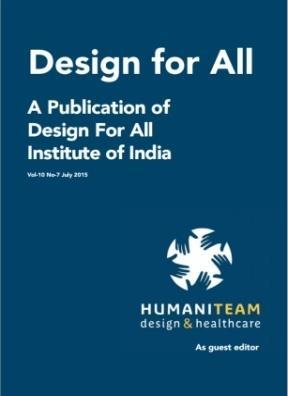
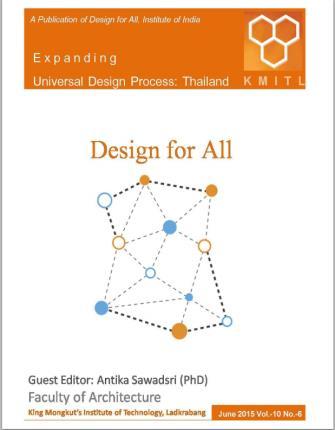
Prof Dr. Cigdem Kaya is chair of department and professor of design at Istanbul Technical University (ITU), Department of Industrial Design. She has been the vice director of Science and Society Research Center (2014-2017) and Industrial Design Graduate Programs Coordinator at ITU (2014-2017). She has been part of I-D team of Learning Lab by Relais Culture Europe, Paris; where she co-develops content and methodology in the field of cultural innovation since 2019.

Cigdem Kaya received Bachelor of Industrial Design from Istanbul Technical University (ITU) in 2003, Masters of Fine Arts in New Genres from San Francisco Art Institute (SFAI) in 2006 and Ph.D. in Industrial Design from ITU in 2011 with co-supervision at Art and Design Center at Sheffield Hallam University (SHU) where she
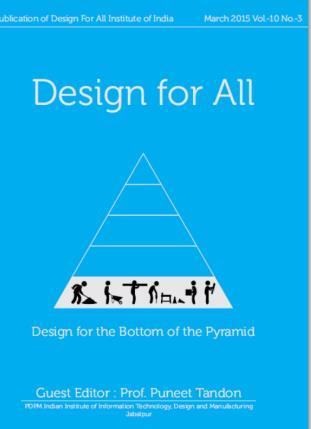
2582-8304
closely studied with Chris Rust. Kaya’s research has been funded by Fulbright and Marie Curie programs. She has published many peerreviewed articles in best design research journals. She supervised 3 PhD thesis about craft, critical making, use-share systems, all of which aim at social innovation and sustainability. In 2020, she has been awarded with one of the most prestigious national research awards: scientific encouragement award by Middle Eastern Technical University Prof.Dr. Mustafa N.Parlar Education and Research Foundation in 2020 for her research on social innovation and sustainability.
December 2022 Vol-17 No-12
Ivor Ambrose
Managing Director, ENAT asbl. Ivor Ambrose has worked in the areas of accessibility and disability inclusion for over 40 years as a researcher, university lecturer, project manager, policy advisor and independent consultant. Born in England, he has lived and worked in the UK, Denmark, Belgium and Greece. He holds a Master’s degree in Environmental Psychology from the University of Surrey, UK and a university lecturer/Ph.D.
qualification from the Danish Building Research Institute, where he specialised in User Evaluation of Environments and new Information and Communication Technologies.
93 October 2022 Vol-17 No-10 Design for All Institute of India

In 2001 he turned his attention to accessibility in the tourism sector, which generally lacked awareness of the needs and specific access requirements of people with disabilities, resulting in inadequate provisions for these travellers. As a researcher and advocate of ‘Design for All, which germinated in Europe in the late 1990s, and ‘Universal Design’ which took hold in the same period in USA, he was part of a movement which challenged policy makers and practitioners in many fields to re-think the way environments, products and services were conceived and designed. Through his research and observations of life, behaviour and cultures, Ivor has developed a driving ambition to make tourism accessible for everyone, everywhere.
In 2008 he co-founded the European Network for Accessible Tourism (ENAT) non-profit organisation (www.accessibletourism.org), with a group of European organisations active in the tourism industry and disability advocacy. He was elected as its Managing Director and has continued in that position since then. ENAT has become the premier membership association for about 300 organisations, business and individuals who support and want to learn more about this area of tourism development. As its director, Ivor manages ENAT’s activities and projects including curriculum development and vocational training courses for hospitality management and staff, European and international standards work on accessibility and tourism, destination management consultancy, certification and provision of accessibility information through online platforms including Pantou, the Accessible Tourism Directory (www.pantou.org). The ENAT Board also maintains links with the UN World Tourism Organisation, the EU Tourism Manifesto Group, the International Social Tourism
2022 Vol-17 No-10 Design for All Institute of India
2582-8304
Organisation, Blue Flag International, Zero Project and many national and regional tourist bodies. Email: enat@accessibletourism.org Athens, April 2022
January 2023 Vol-18 No-1
IMMA BONET
After high education in Pharmacy in the University of Barcelona, she developed her professional carrier in the field of healthcare, associations, education, accessibility and Design for All.
From 1975 to 1980, she was Head of the Haematology Department at the Hospital San Juan de Deu (Barcelona) and from 1994 to 1997 representative of the people with mental disabilities sector in the Governing Council of the Institut Municipal de les Persones amb Disminució de Barcelona.

From 1995 to 2000 she was responsible for the External Relations in the Resources Centre for Personal Autonomy that belongs to the Barcelona Province Government.
From 2001 to 2021, she became Executive Patron of the Design for All Foundation where she is responsible for the general management.
95 October 2022 Vol-17 No-10 Design for All Institute of India
2582-8304
She has been responsible for the development of many national and international projects in her position as: Design for All in Spanish Universities, The Flag of Towns and Cities for All, Museum for All, Society for All, Auditing system for the use of Design for All in companies and has coordinated the participation of the Design for All Foundation in the European project IDeALL (Integrating Design for All in Living Labs) on processes of co-creation with users. She has been also lecturer in several Spanish Universities, design schools and congresses.
From 2022, she is currently a freelance Design for All consultant working for organisations like Design for All International, Moventia, City of Oslo, Avanti-Avanti Studio and ProAsolutions among others.
February 2023 Vol-18 No-2
Amelia Dray
Amelia is a designer exploring childhood, play, and democracy. Her interdisciplinary practice works across fields such as leadership development, organisational change, service design, and child culture design. Her work aims to explore local forms of democracy alongside, with and for children.
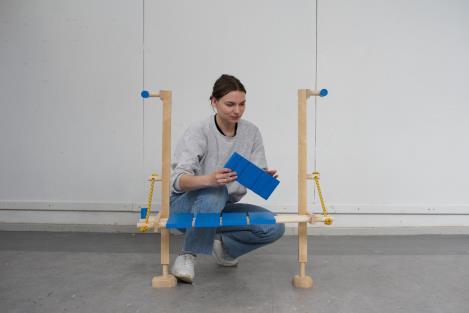
Amelia is a strong advocate for children’s play, how children lead, and how they offer new perspectives and wisdom. These concepts infuse her work across multiple contexts; working on large organisational change programmes overseas and in the UK, led
96 October 2022 Vol-17 No-10 Design for All Institute of India
2582-8304
design work with schools, charities and local + central government, and continuously developing her material practice as a designer.
November 2023 Vol-18 No-11
Dr. Soumyajit Bhar is currently an Assistant professor of environmental studies at Krea University, India, where he offers and coordinates a course on Design Thinking. Soumyajit straddles action and academic research with more than 14 years of experience (both volunteering and full-time) working with various environmental and sustainability issues. He holds a Ph.D. in Sustainability Studies (with a specialization in ecological economics) from Ashoka Trust for Research in Ecology and the Environment (ATREE) as part of a unique interdisciplinary Ph.D. program. His dissertation attempts to understand socio-psychological drivers and local and regional scale environmental impacts of conspicuous/luxury consumption basket in India. Soumyajit is furthering postdoctoral research at the intersection of rising consumerism, sustainability concerns, and inequality levels in the context of the Global South. He is also keen to explore how design education can broaden students' perspectives and help them delineate pathways to a better world. He has published in international journals and popular media. He is also interested in larger questions of philosophy and ethics, particularly pertaining to environmental issues.
97 October 2022 Vol-17 No-10 Design for All Institute of India

New Books
it is available on www.morebooks.de one of the largest online bookstores. Here's the link to it: https://www.morebooks.de/store/gb/book/design for all/isbn/978 613 9 83306 1
98 October 2022 Vol-17 No-10 Design for All Institute of India

Are you looking for housing options that are safer and more accommodating for independently aging in place? Do you want to enjoy comfort, accessibility, safety and peace of mind despite your disabilities, limitations and health challenges? The help you need is available in the Universal Design Toolkit: Time saving ideas, resources, solutions, and guidance for making homes accessible.
This is the ultimate resource for individuals and professionals who want to save time, money and energy when designing, building, remodeling or downsizing a home. The Universal Design Toolkit will help you take the steps to design homes for your clients or yourself while eliminating the costly trial and error challenges you’d inevitably encounter if faced with this learning curve on your own.
Rosemarie Rossetti, Ph.D., teamed with her husband Mark Leder in creating this unique Toolkit. They bring ten years of research, design and building expertise by serving as the general contractors for their home, the Universal Design Living Laboratory which is the highest rated universal design home in North America.
Within the Toolkit’s 200 richly illustrated pages, you’ll find: Insights that distinguish essential products, services and resources from the unnecessary.
Proven, realistic tips for finding the right home.
Home features you need to look for. Nothing is assumed or left out.
Handy home checklists and assessments.
Interview questions to help you hire industry professionals with knowledge and experience. Photographs that provide a frame of reference to inspire, clarify and illuminate features andbenefits.
Valuable resources to save you time, money and energy.
Helpful sources of funding.
Space planning dimensions for access using assistive devices such as wheelchairs andwalkers.
And so much more!
If you want useful, dependable advice and easy to implement ideas from respected experts who know the ropes, you’ll love Rossetti and Leder’s perspective. As a speaker, author and consultant who uses a wheelchair, Rossetti has helped hundreds of people design their ideal homes. Now her comprehensive Toolkit is available to help and support you!
Get the Universal Design Toolkit now to start your project!
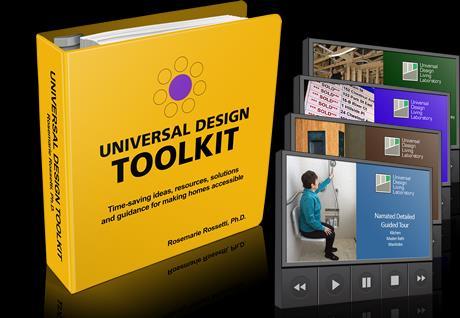
100 October 2022 Vol-17 No-10
for All Institute of India


Available as a paperback (320 pages), in black and white and full colour versions (book reviewed in Design and Technology Education: An International Journal 17.3, and on amazon.com).
The 2018, eBook edition is available in mobi (Kindle) and ePub (iBook) file versions on the amazonand other worldwide networks; includingon the following websites:
ePubversion:www.booktopia.com.au
https://www.booktopia.com.au/ebooks/product design elivio bonollo/prod9781784562946.html mobi (Kindle versions):www.amazon.in
https://www.amazon.in/Product Design Course First Principles ebook/dp/B07FNV2F4L/ref=sr_1_1?ie=UTF8&qid=1532999395&sr=8
1&keywords=Product+Design%3A+A+course+in+first+principles www.amazon.com
http://www.amazon.com/Product Design course first principles/dp/1784562939/ref=sr_1_sc_1?ie=UTF8&qid=1456434322&sr=8 1

spell&keywords=Bonollo+Product+Design%3A+A+course+infirst+principles www.amazon.com.au
https://www.amazon.com.au/Product Design Course First Principles ebook/dp/B07FNV2F4L/ref=sr_1_fkmr0_1?ie=UTF8&qid=1532497383&sr=8 1 fkmr0&keywords=Product+Design+a+course+in+first+principles
READING HINTS: ePub files can be read with the iBook app on Apple MacBook/iPad devices; ePub files can also be read on Desktops PCs, Laptops and Surface devices using readers such as the Microsoft fredaePub reader. The Kindle (mobi file) reader isflexible and suitable for reading the eBook on PCs; Kobo readers can also be used to read ePub files on MacBook and iPad. All formats are very interactive with very good navigation.
102 October 2022 Vol-17 No-10 Design for All Institute of India
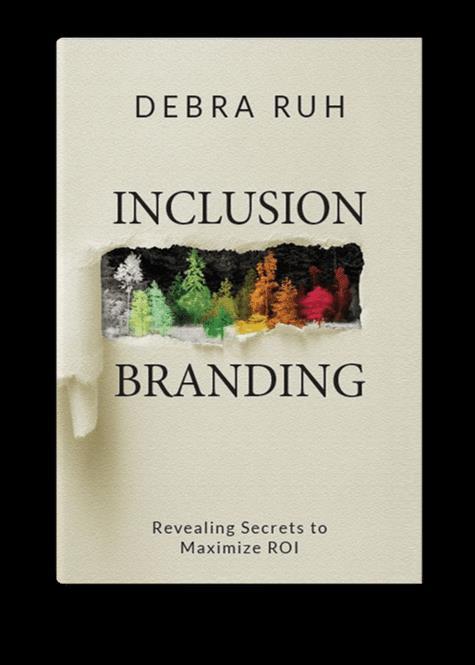
In light of the forthcoming United Nations Conference on Housing and Sustainable Urban Development (HABITAT III) and the imminent launch of the New Urban Agenda, DESA in collaboration with the Essl Foundation (Zero Project) and others have prepared a new publication entitled: “Good practices of accessible urban development”.
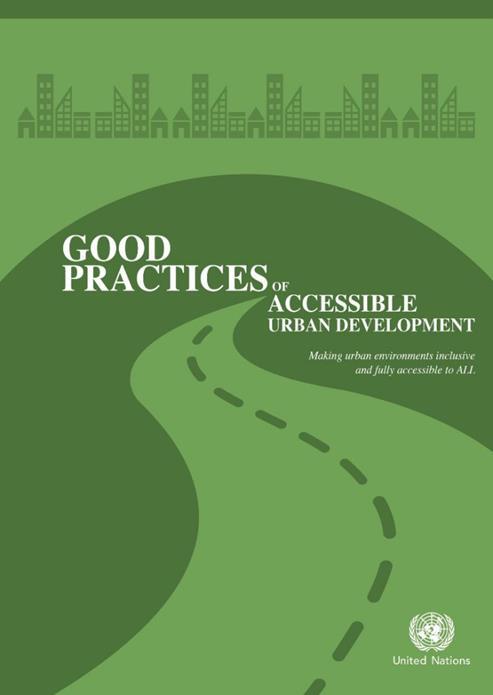
The publication provides case studies of innovative practices and policies in housing and built environments, as well as transportation, public spaces and public services, including information and communication technology (ICT) based services.
The publication concludes with strategies and innovations for promoting accessible urban development.
The advance unedited text is available at:http://www.un.org/disabilities/documents/desa/good_practices_urban_dev.pdf
2022
for All Institute of India
Dr Chih-Chun Chen and Dr Nathan Crilly of the Cambridge University Engineering Design Centre Design Practice Group have released a free, downloadable book, _A Primer on the Design and Science of Complex Systems_. This project is funded by the UK Engineering and Physical Sciences Research Council (EP/K008196/1).
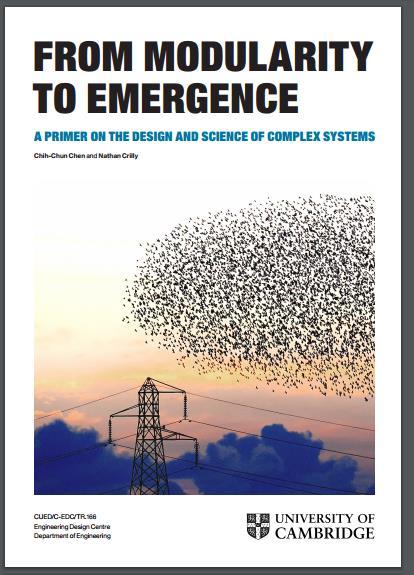
The book is available at URL: http://complexityprimer.eng.cam.ac.uk
105 October 2022 Vol-17 No-10 Design for All Institute of India
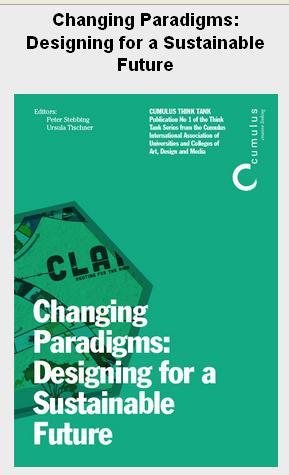
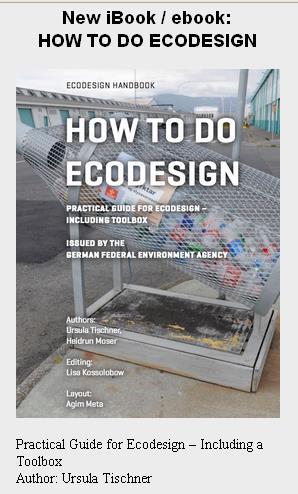
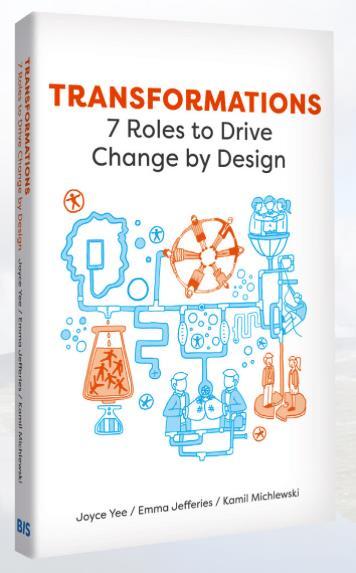
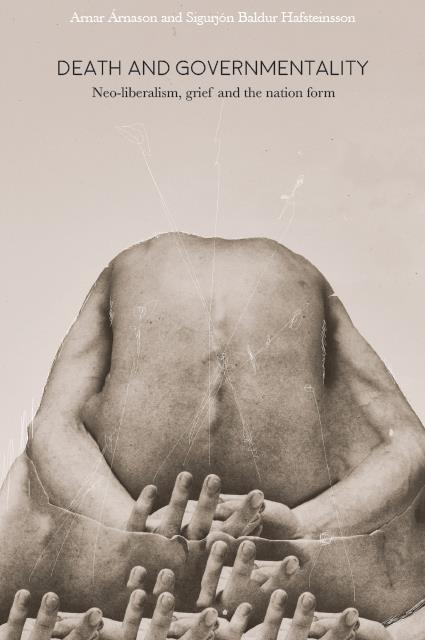
Universal Design: The HUMBLES Method for User-Centred Business
“Universal Design: The HUMBLES Method for User Centred Business”, writtenbyFrancescAragall and JordiMontañaandpublishedbyGower, providesaninnovativemethod to supportbusinesseswishing to increase the number of satisfiedusersand clients andenhancetheirreputationbyadaptingtheirproductsandservices to the diversity of their actual andpotentialcustomers, takingintoaccounttheirneeds, wishesandexpectations.

The HUMBLES method (© Aragall) consists of a progressive, seven phaseapproach for implementing Design for All within a business. Byincorporating the user’spoint of view, itenablescompanies to evaluatetheirbusinessstrategies in order to improveprovideanimproved, morecustomer orientedexperience, andtherebygain a competitiveadvantage in the marketplace. As well as a comprehensiveguide to the method, the bookprovidescasestudies of multinationalbusinesswhichhavesuccessfullyincorporated Design for All intotheirworkingpractices.
According to SandroRossell, President of FC Barcelona, who in company withotherleadingbusiness professionals endorsed the publication, it is “requiredreading for thosewhowish to understandhow universal design is the onlyway to connect a brand to the widest possible public, increasing client loyaltyandenhancing company prestige”. To purchase the book, visiteither the Design for All Foundation website
2022
Design for All Institute of India
1.
Universal and Inclusive Design
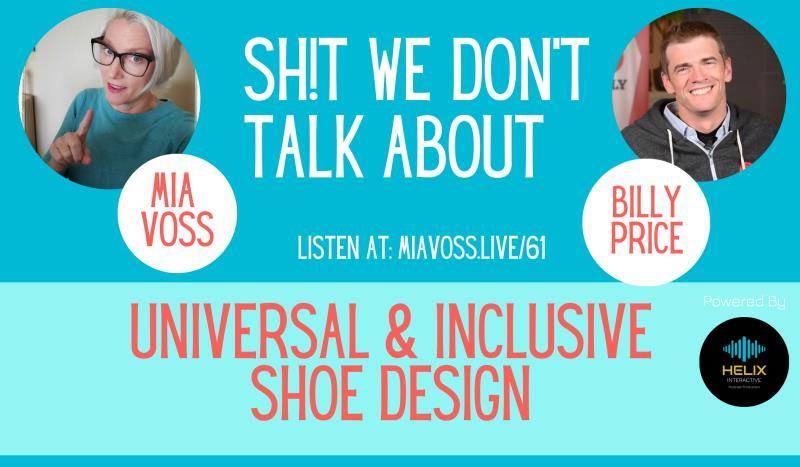

Billy wanted to create designs that work for everyone, not just for people with disabilities.
The Highlights
UNIVERSAL DESIGN – This is a term that came out of architecture. Universal design is all about creating spaces that work for everyone, where ALL people can work or live, and any equipment required to maintain or operate that space also works for everyone. Billy Footwear set out to apply this concept to fashion, creating footwear that levels the playing field and works for everyone.
The origins of Billy Footwear come out of Billy’s lived experience. Billy broke his neck and back in a three-story fall early in his engineering education. The outcome was instant
paralysis and life in a wheelchair, which forced Billy to find ways to get around his disability and take care of himself. When finding shoes became a problem, he set out to solve that problem.
Billy wanted to create designs that work for everyone, not just for people with disabilities. Billy’s own home – his condominium – was designed and renovated to accommodate Billy’s use of a wheelchair. But when he sold the condo, it was sold to people that are not wheelchair users and had no idea that someone with a wheelchair lived in the space. THAT is universal design.

Whenever possible, universal design trumps adaptive design. Even people without disabilities can encounter temporary mobility issues due to injury, and we all age and can encounter

2022
Design for All Institute of India
mobility issues as a natural part of life. Why not design to accommodate those issues automatically rather than assuming that everyone is fully mobile all the time?
When Billy and his partner created the first Billy Footwear shoes, it was important to create shoes that did no look like “adaptive” shoes. Billy Footwear shoes look like shoes. Until you wear them, you would not see them as anything different from what you’re used to wearing already.
Inclusive design has become a synonym for adaptive design. Adaptive design is design for disabilities. Inclusive design – in Billy’s world – is designed for everyone regardless of ability. Rather than keeping everyone in their own silo, Billy would rather tear down all the silos and put everyone on the same playing field using principles of universal and inclusive design.
“You gotta feel good about what you’re wearing. It just builds confidence.”
– Billy PriceAbout Billy Footwear
BILLY Footwear is the brainchild of two Seattle locals: Darin Donaldson and Billy Price. Our focus is on shoes that embody universal design, meaning they both appeal to and work for everyone. Smashing fashion with function, BILLY Footwear incorporates zippers that go along the side of the shoes and around the toe, allowing the upper of each shoe to open and fold over completely. Thus the wearer can place his or her foot onto the shoe footbed unobstructed. Then with a tug on the zipper pull the shoe closes and secures overtop the user’s foot. It’s simple. It’s easy.
This post was previously published on Mia Voss’ blog.
Good Men Project
All Institute of India
Programme and Events

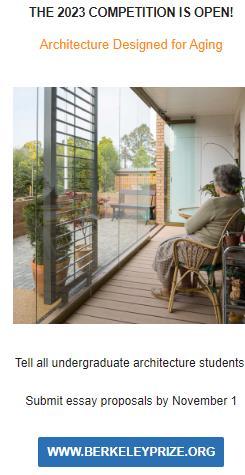
Rewarding Design Excellence


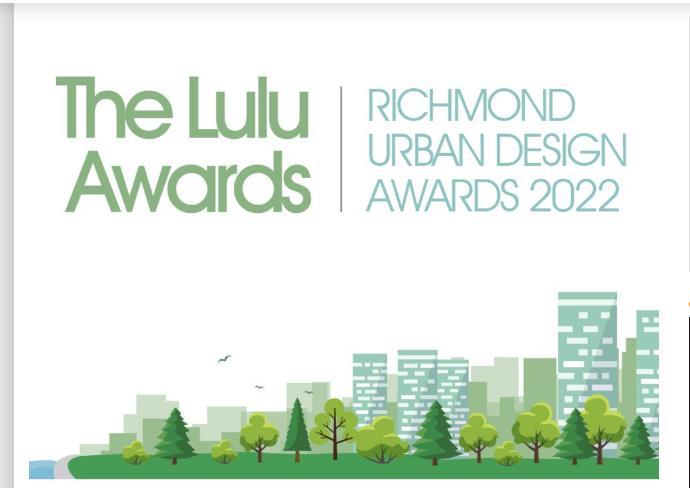
Hyderabad Regional Chapter of IIID (Institute of Indian Interior Designers), is hosting the fourth edition of its flagship event “IIID Showcase Insider X 2022
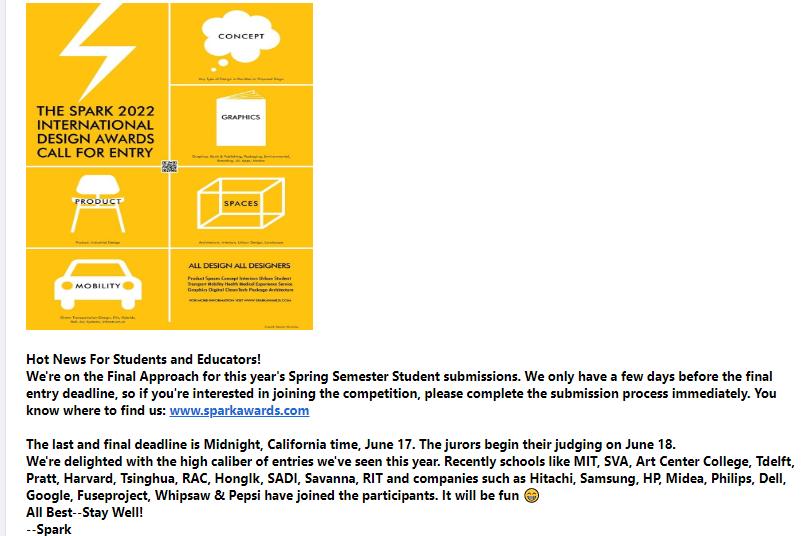

National Centre for Promotion of Employment for Disabled People (NCPEDP) is a nonprofit voluntary organization founded in 1996 and works as an interface between various stakeholders Government, Industry and Civil Society Organizations (both national and international) for the empowerment of persons with disabilities.
NCPEDP has always believed that empowerment is the key to inclusion, with education and employment playing a significant role in ensuring the sustained and overall development of persons with disabilities.
October 2022 Vol-17

2582-8304
In order to recognize and honour accomplishments in the field of employment of persons with disabilities, NCPEDP in 1999, launched the Helen Keller Awards. Over the years, these Awards have come to be recognized as the most prestigious benchmark for honouring people and organizations that have worked towards a barrier-free, a nondiscriminatory and inclusive work environment with a special focus on persons with disabilities.
This is the 7th year of The NCPEDP and Mindtree’s partnership for the Helen Keller Awards. The Awards will be given away under the following 4 categories:
Category A: Role Model Persons with Disabilities
Category B: Role Model Supporter of Increased Employment Opportunities for People with Disabilities
Category C: Role Model Companies/NGOs/Institutions
Role Model Entrepreneurs with Disabilities
The Concept Note along with the Nomination Forms are attached here We have also enclosed last year's commemorative brochure for your reference.
The last date for submitting the nomination is 20th October 2022.
We would appreciate it if you could nominate deserving candidates/organizations. Self nominations are also accepted.
Also, it would be great if you could disseminate the Concept Note and the Nomination Forms to all individuals/organizations on your mailing lists. They can also be downloaded from https://ncpedp.org/the ncpedp mindtree helen keller awards 2022/
Your support will help us reach out to the maximum number of people spreading awareness, and identifying and honouring the best role models from across the country.
Please send us your nominations at asifa.ncpedp@gmail.com or secretariat.ncpedp@gmail.com
118 October 2022 Vol-17 No-10 Design for All Institute of India
Job Openings
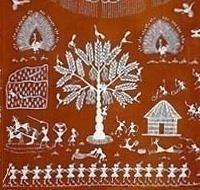
Contact Design for All Institute of India

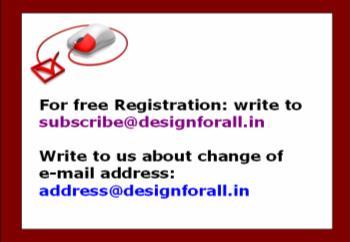
Advertising:
To advertise in digital Newsletter
advertisement@designforall.in
Acceptance of advertisement does not mean our endorsement of the products or services by the Design for All Institute of India
News and Views:
Regarding new products or events or seminars/conferences/ workshops.
News@designforall.in
Feedback: Readers are requested to express their views about our newsletter to the Editor
Feedback@designforall.in
Forthcoming Events and Programs:
Editor@designforall.in
The views expressed in the signed articles do not necessarily reflect the official views of the Design for All Institute of India.
120 October 2022 Vol-17 No-10 Design for All Institute of India
ISSN: 2582-8304
Chief-Editor:
Dr.Sunil Kumar Bhatia Faculty Member, 13, Lodhi Institutional Area, Lodhi Road, New Delhi-110003(INDIA)



E-mail:dr_subha@yahoo.com
Editor:
Shri L.K. Das
Former Head Industrial Design Center, Indian Institute of Technology (Delhi), India
E-mail: lalitdas@gmail.com
Associate Editor:
Prof Dr Rachna Khare, School of planning and Architecture , Bhopal, India E-mail: rachnakhare@spabhopal.ac.in

Editorial Board:
Prof Dr.Gaurav Raheja, Indian Institute of Technology, Roorkee, India Email: gr.iitroorkee@gmail.com

Prof Dr. Sugandh Malhotra, Indian Institute of Technolgy, Mumbai, India Email: sugandh@iitb.ac.in
121 October 2022 Vol-17 No-10 Design for All Institute of India
ISSN: 2582-8304
Prof Dr Ravindra Singh, Delhi Technological University, India Email: ravindra@dtu.ac.in

Special Correspondent: Ms. Nemisha Sharma, Mumbai, India Nemisha98@gmail.com
Address for Correspondence: 13, Lodhi Institutional Area, Lodhi Road, New Delhi-110 003India.
Material appearing in this journal may be freely reproduced. A copy of the same and acknowledgement would be appreciated.
This journal is published monthly for free for benefits for readers, by Design for All Institute of India,/ 70 Sector-18 Rohini, Delhi110089 (INDIA) and publisher name Dr. Sunil Kumar Bhatia, address A/2/70 Sector-18 Rohini, Delhi-110089 Tel: +91-1127853470 ,E-Mail: dr_subha@yahoo.com
This publication is completely free .We do not charge anything for published items in this journal from contributors .
Disclaimer:
While every effort is made to check the accuracy of the contributions published in Design for All, the publisher do not accept responsibility for the view expressed which, although made in good faith, are those of the authors alone Web site: www.designforall.in
Special request should be addressed to Dr_subha@yahoo.com
ISSN : 2582-8304
122 October 2022 Vol-17 No-10 Design for All Institute of India
